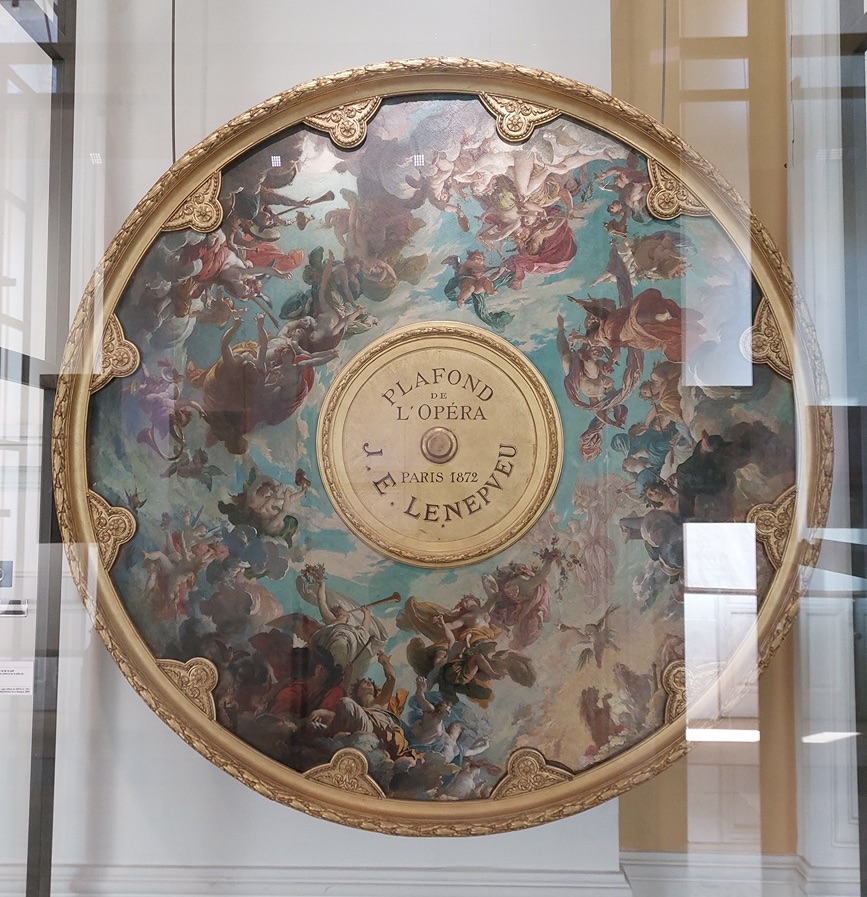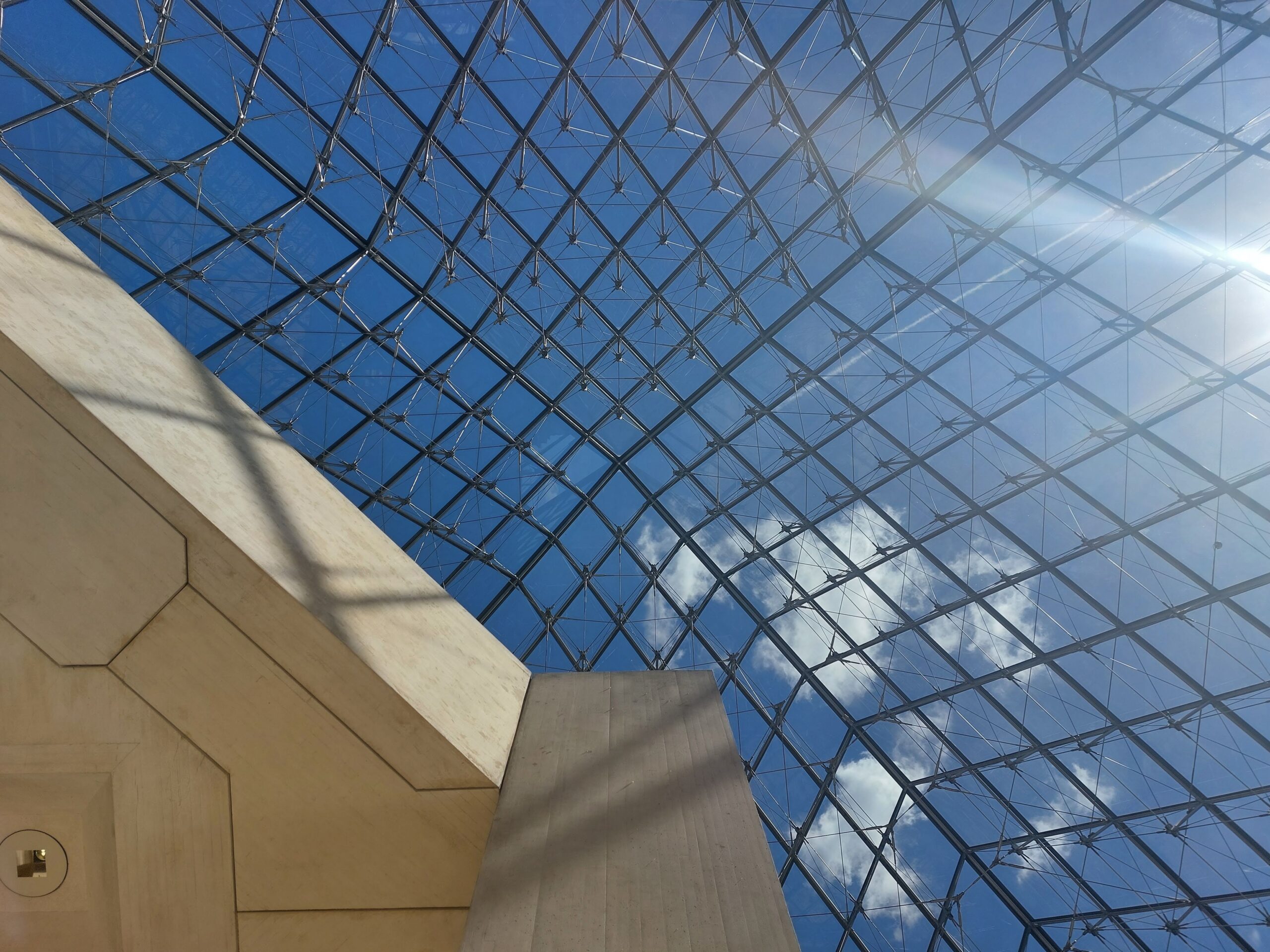This post will give you an overview of possible Things to Do during your upcoming visit to Paris, France. But not only that. It will also give you tips on:
- Getting Around
- Buy Tickets or a Paris City Pass
- Some interesting Walking Tours
- Unforgettable Day-trips from Paris
- Tips on Personal Safety
- Where to Take a Break & much more.
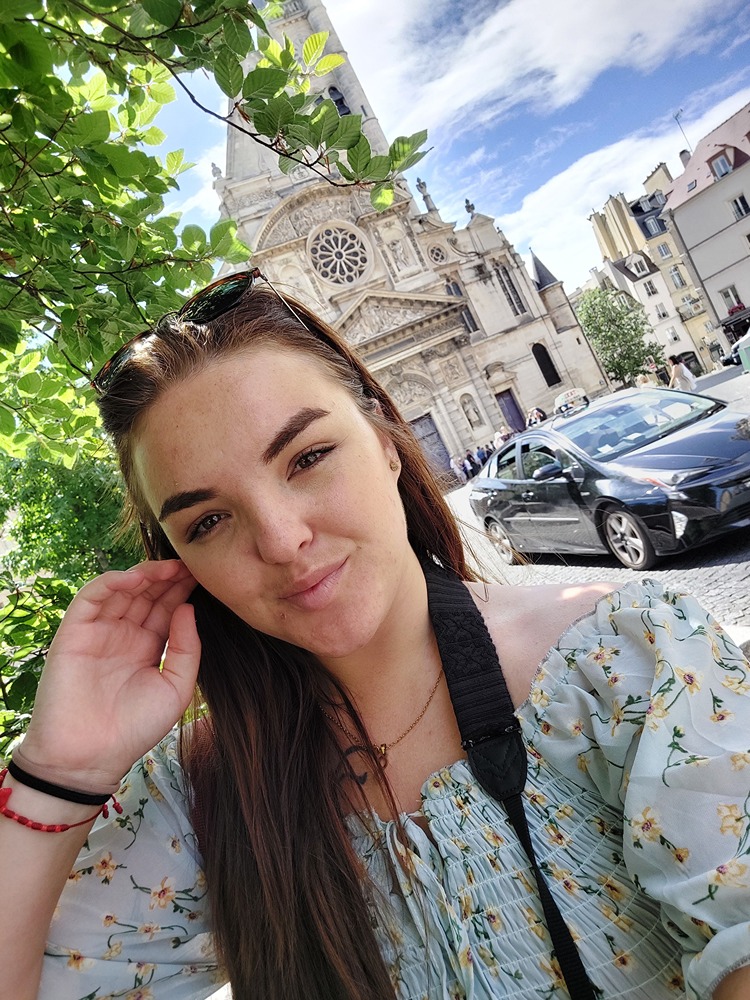
This blog post is the first one that is written by me & my daughter Lisa. I’ve visited Paris twice in the past, but she was there just recently. Able to add new information & photos to the impressions I had earlier on.
- IMPORTANT: Throughout this post you’ll find affiliated links provided by affiliate marketing platforms like Viator, GetYourGuide, Tiqets, Expedia & others. Links & ads that may help you plan your next trip to Paris.
- If you click on them & buy a ticket for a museum, book a tour or rent a bike a small commission of your purchase will go to me (paid by the provider, without any extra cost to you).
- If you want to learn a little bit more about me, the blog writer, click on: Better call me Art.

Paris, a short Introduction
A visit to Paris is on many traveler’s wish list. For sure, one of the most beautiful cities in Europe & the world. Romantic in every sense, even its name. Paris, the “City of Light“.
- A nickname that has many explanations, but most probably goes back to the year 1667. The moment that King Louis XIV – the Sun King – decided to fight crime by installing street lighting in every street & on every corner.

painted by Hyacinthe Rigaud.
So, if Paris is your next travel goal: congratulations. Paris is a Top destination, offering something for everybody. There’s a lot to enjoy & discover. Historical, cultural, fun, relaxing, culinary… whatever you want. A visit to Paris is something you will never forget.
To make it unforgettable though, it’s best to prepare yourself as good as possible. Something we want to help you with.
The main goal of this particular blog post is to tell you about the best Things to Do in Paris. Throughout though, we will give you Useful tips & ideas on many other aspects.
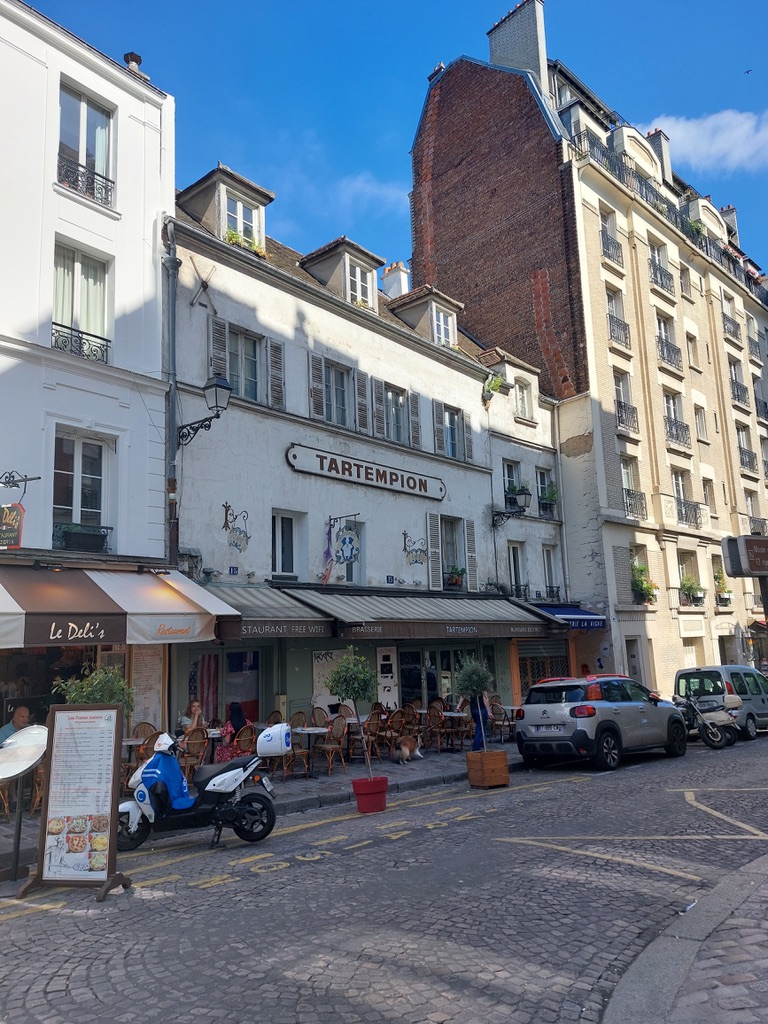
TravelTips: As this is an extensive blog post, we recommend you to study the Index above. Besides the optional THINGS TO DO, there are loads of TravelTips (always printed in red).
What ATTRACTIONS to visit in Paris, France
- In the first part of this blog post we’ll give you a description of the Biggest Attractions.
- Followed by lesser-known Things to Do or Hidden gems that will surprise you.
- Finally, we’ll give you an idea of several worthwhile Day-Trips from Paris.
TRAVELTips: Buy Tickets/ Passes in advance?
- Before we talk about tickets & passes, it’s IMPORTANT to know that most attractions (like museums) are FREE for people under 18 & and for EU-residents between 18-26 years of age. As well as for people with a disability & one accompanying person.
- Also IMPORTANT is that many museums & other monumental attractions are closed on Mondays… So, be prepared and plan your visit accordingly.
Tickets
As Paris attracts millions of visitors a year it’s recommendable to buy your tickets in advance.
In the first place, tickets for the most popular attractions like the Eiffel Tower, the Louvre, a boat tour on the river Seine or a Day-trip to Versailles. But also for many other attractions that receive less visitors, but still – and mostly during the high season – get long lines of people wanting to get in.
- That said, having bought a ticket beforehand doesn’t always mean you can skip all the lines. At many attractions there are actually two long lines. One to buy a ticket (if still available) & the other to get in. So often you only skip one line when you’ve bought your tickets in advance. Still gaining lots of time though.
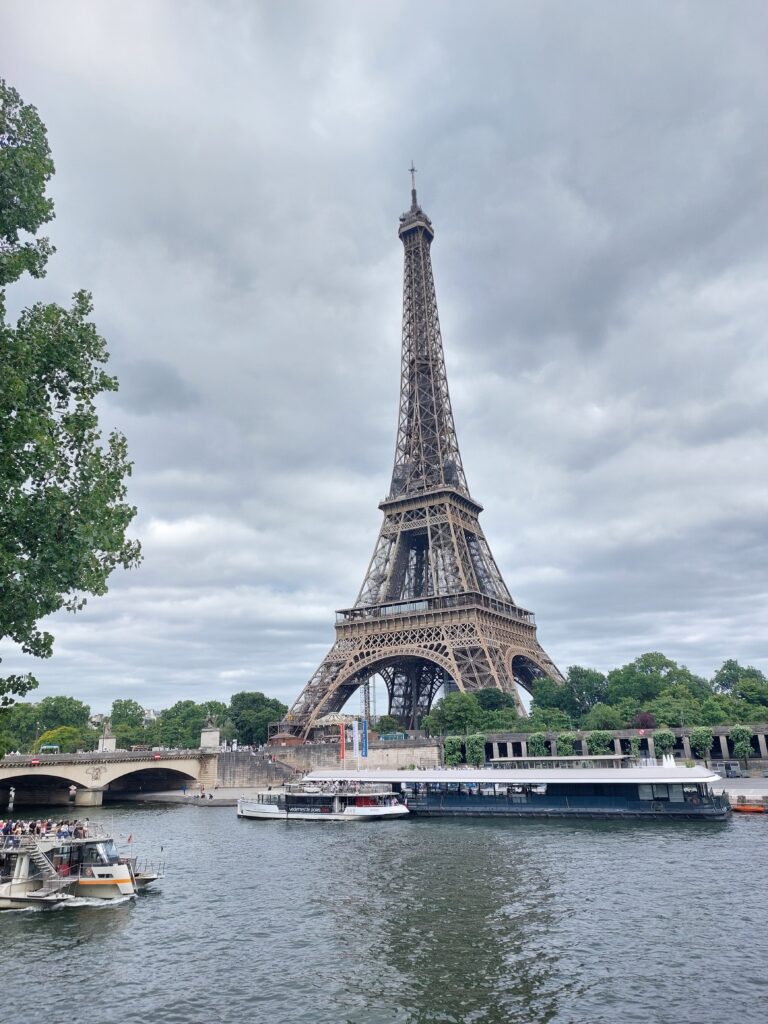
City Passes
Alternatively – depending on the things you like to do – there are City Passes that give you direct access to many attractions, gaining time & money.
There are many travel platforms which offer a City Pass for Paris, but to make things easier I’d like to recommend you to have a look at the two passes Go City has to offer: the All-Inclusive Pass and the Explorer Pass.

To learn more, go to: Go City Passes for Paris
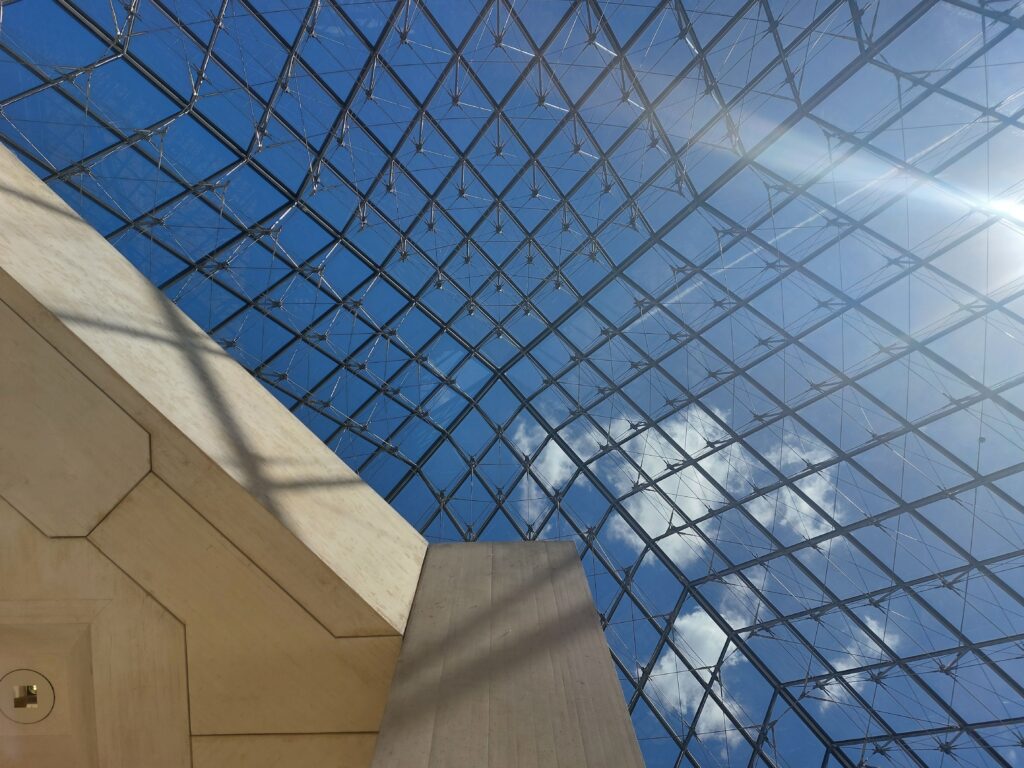
A visit to the Eiffel Tower, Paris
Let’s start with…
Who hasn’t heard of the Eiffel Tower?
It’s one of the best known monumental attractions in the world. A monument that most people will mention, when asked to name a few Paris’ highlights.
- Le Torre Eiffel was designed & built (1887-1889) by the Compagnie des Établissements Eiffel. Although it carries the name of engineer Gustave Eiffel, the tower was actually designed by two colleagues who worked for the Company: Maurice Koechlin & Émile Nouguier & embellished by the architect Stephen Sauvestre.
- The design was inspired by an earlier construction. A wooden tower that was built for the 1853 Industrial Exhibition in Manhattan, New York. This tower, the Latting Observatory, was 96m/ 315ft high. It was demolished after the exhibition ended in 1854.

- Besides being responsible for the construction of the Torre Eiffel, Gustave Eiffel left us other famous building projects worldwide. The Statue of Liberty, in the New York Harbour, being the most famous one. A gift of the French people to the Young United States (designed by Eiffel’s compatriot Frédéric Auguste Bartholdi).
A tourist landmark for Paris
Although criticised by some, from the get go La Dame de Fer – the Iron Lady – has been a MUST SEE for every visitor to Paris. Well, … that should go without words really, because you can see it from a large distance & millions of tourists visit the main attraction of Paris every year.
That is, they actually “climb” the Eiffel Tower.
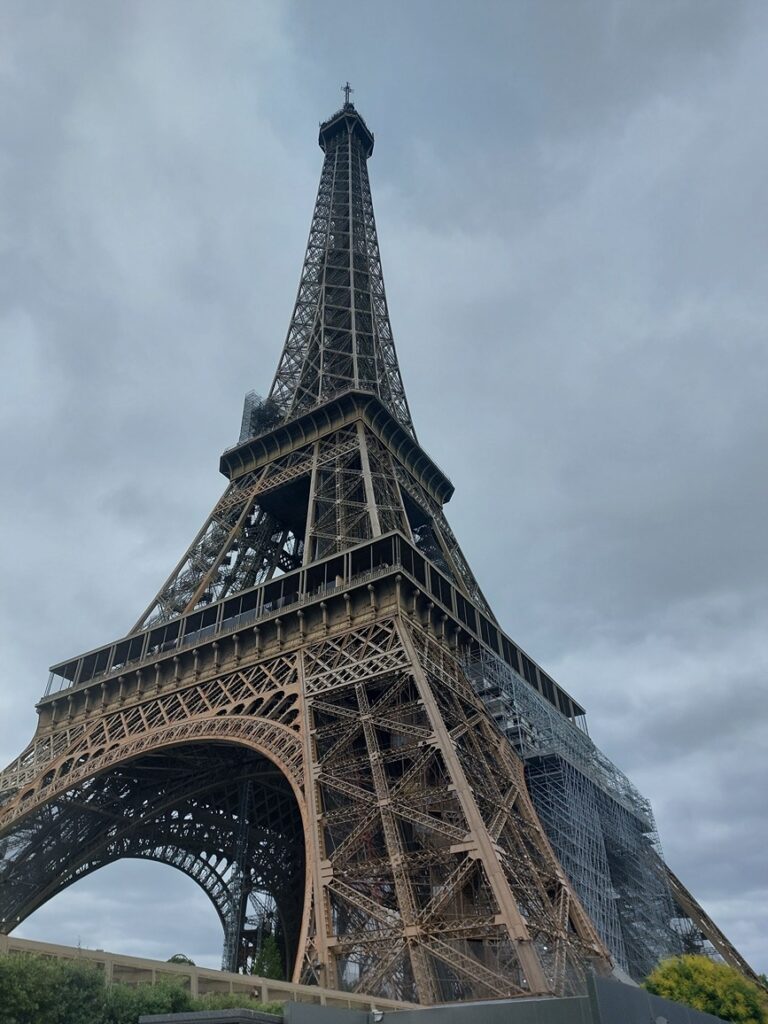
TRAVELTips: Visitor Tips for the Eiffel Tower
There are actually two ways to go up. One is to take the stairs: 327 steps to the first level & 347 more to the second. From there – although there are 991 more “emergency” steps up – you have to take the elevator to level 3.
- The third floor is 276m/ 906 ft from ground level. The tower is higher though, with 330m/ 1083 ft the highest building of Paris.
Opting for the tiresome stairs doesn’t mean it’s for FREE. In other words, you still have to buy a ticket to climb up. That’s why most people buy a ticket for the elevator, which you’ll need to buy well in advance.
To know if tickets are still available for the dates you’ll visit Paris, you can use the following calendar:
Besides the spectacular view of the City of Light, on the first & second level you’ll find some good restaurants & even a champagne bar to celebrate your presence at a very special world famous spot.
Behold… the Eiffel Tower
Alternatively, you can admire Paris’ biggest landmark from below. Taking a cup of coffee or a glass of wine on ground level. Or else, organising a picnic for yourself or your company in the park.
A view of the Eiffel Tower is always special, but at night it converts into something spectacular. Just waiting for the lights to turn on while it’s getting darker. A beautiful, unforgettable experience.
That said, you may be concerned about safety in the evenings. Well, don’t worry too much, because you’re always surrounded by hundreds of people waiting for the lights to go on. Just be aware of your surroundings. Always in a big city.
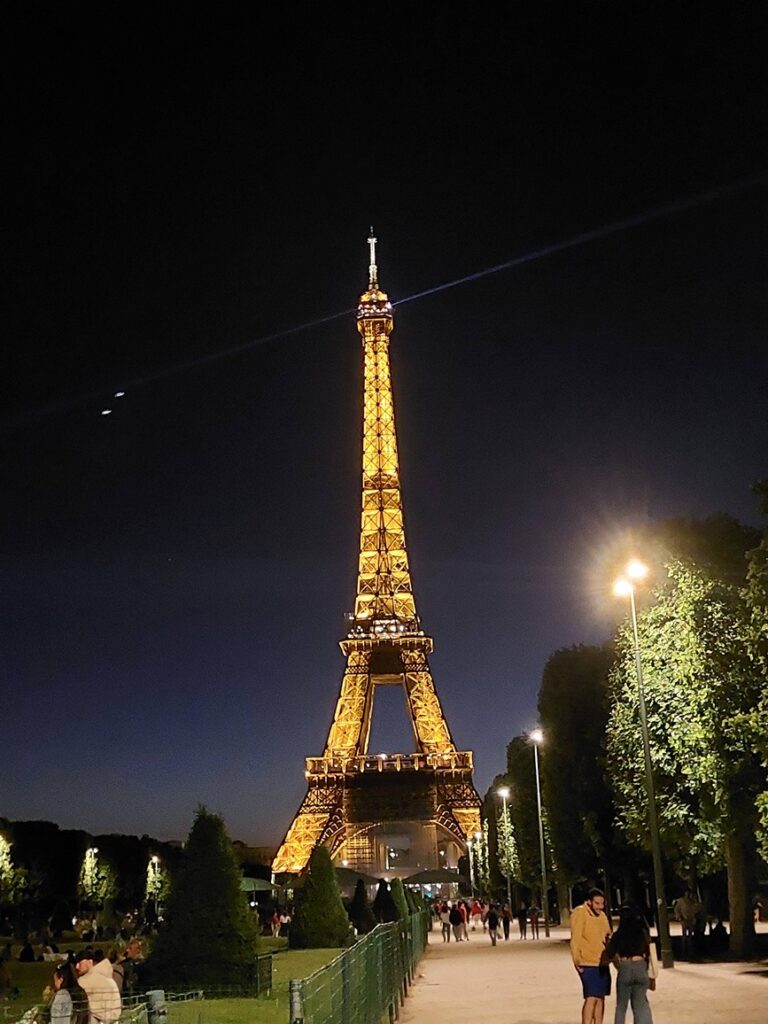
Other attractions in the vicinity of the Eiffel Tower:
Eiffel Tower Carousel, Champ de Mars, Trocadéro Gardens & Square, Aquarium de Paris, Musée de l’Homme.
TRAVELTips: Getting around in Paris
On Foot
Many visitors like to walk the city. Possible. At least partially we would say.
See following map to get an idea of the distances when planning your itinerary (with thanks to Le Parisien daily newspaper).
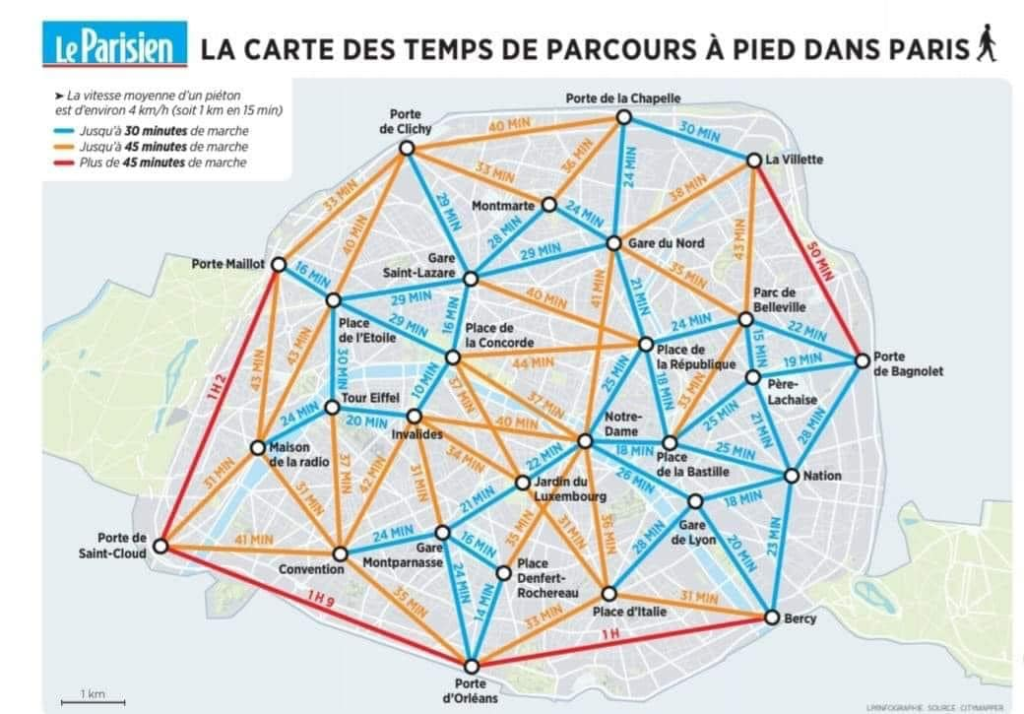
Public Transport
There are several options to get around. The cheapest way is to use public transport. First of all, the metro (2,15€ for a single trip).
If you stay for a few days though I recommended the Paris Visite Travel Pass. With this pass you can choose between 1, 2, 3 or 5 days, paying between 13.95€ and 44.45€ (hals the price for children between 4-11 years).
- For more info, go to: Paris Visite Travel Pass
- To find out how to travel from your current location to a certain destination you can use Google Maps. Google can – for example – indicate exactly where you’ll find the nearest bus stop, at what time the bus arrives, if you have to change buses & finally, how long it takes to get to your chosen destination.
Rent a Bike or eBike
Another affordable way of getting around is to rent an (electric) bike. There are several private companies who rent them – like Lime, Donkey Republic & Vélib’ – which have stations spread all over town.
- You have to be aware though that generally – at the end of your ride – you have to stall the bike at one of the service stations of the same company & hire another bike the next day.
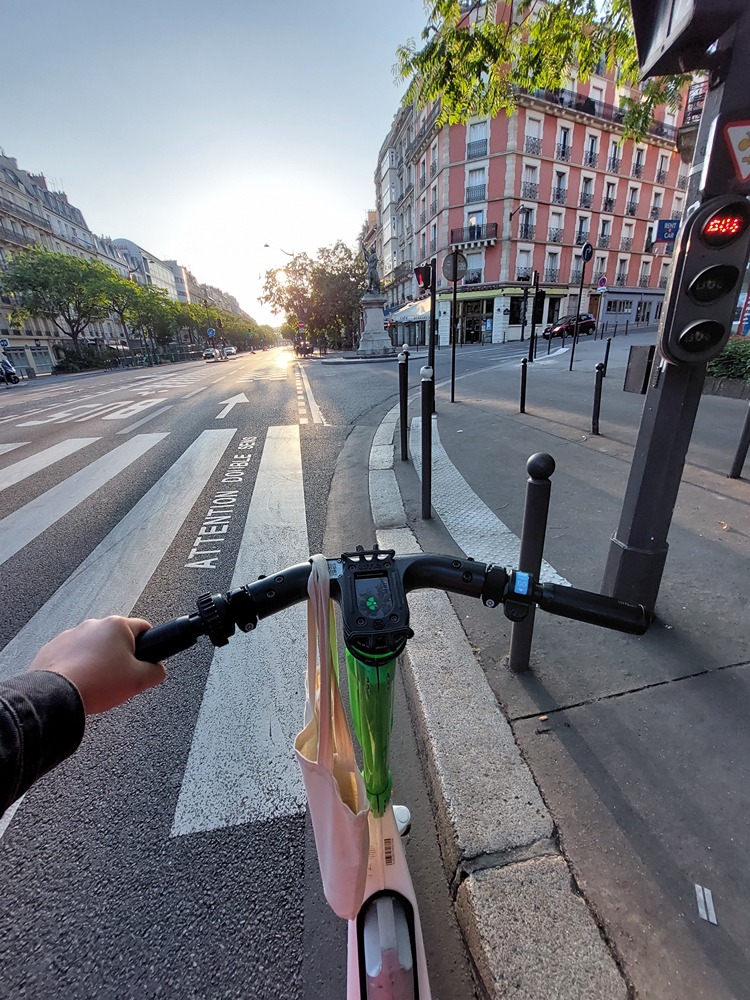
Alternatively, there are some organized bike tours in Paris.
If you want to know more about these popular tours, click on: Paris Bike Tours
Use a Taxi
In Paris, you can find taxi stands everywhere, but it’s also possible to hail one. If free, hop in & ask the taxi driver to put the meter on.
Alternatively, you can “Order a taxi”. There are many options when you google it on the internet (Uber, as well as several local transfer companies).
Hop-on & Hop-off
Finally, for a quick overview of the inner city, you can buy a 24 or 48 hour pass for the Hop-on Hop-off bus. The so-called Tootbus – which runs daily between 9:30 & 18:30 – which connects the main tourist areas of Paris. A fun way to get a first impression of Paris.
To learn more, click on: Paris Hop-on Hop-off Tootbus




Alternatively, there’s an option to do: A night bus tour of the City of Lights
A visit to the Louvre, Paris
As one of the biggest museums in the world, The Louvre attracts millions of visitors a year.
- Initially the Louvre was built as a fortress, adjoining the defensive wall around the city of Paris. Construction began at the end of the 12th century.
- Between the 14th & the 18th century the Louvre regularly served the Royals of France as a residence. That is, until the Sun King, Louis XIV, moved his court to Versailles in 1682.
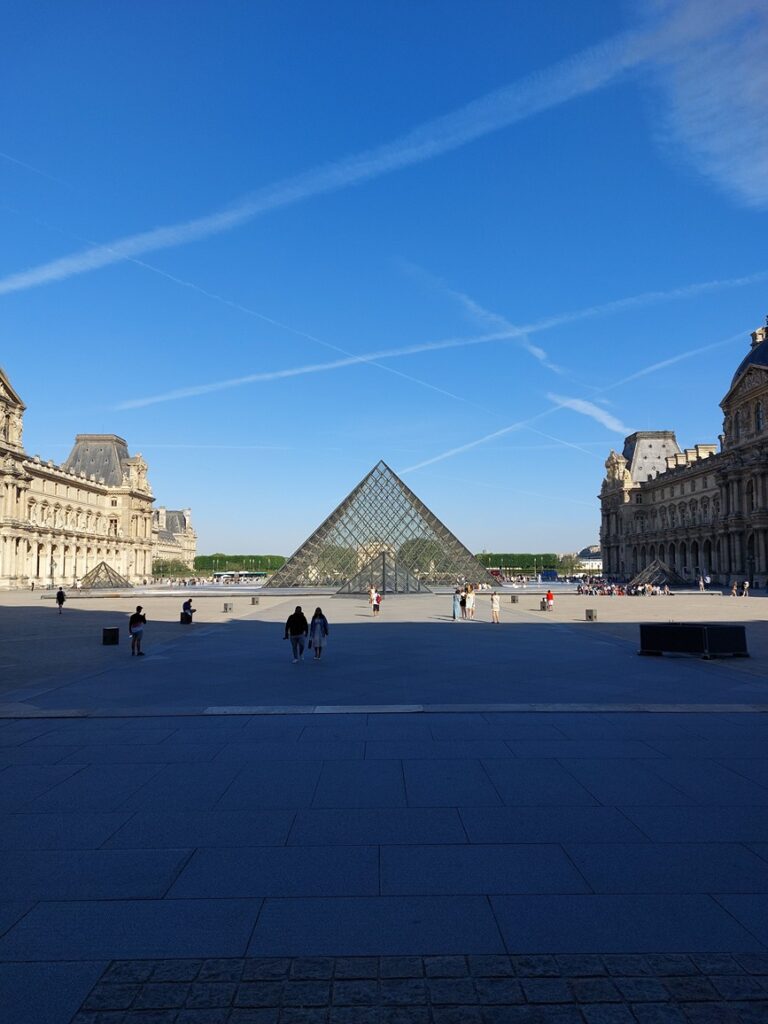
The Louvre became a museum during the French Revolution (in 1793). Today the museum has one of the largest Art collections in the world.
- As the collection grew, adjustments had to be made. Like the modern entrance, which was inaugurated in 1988. In the form of an enormous glass pyramid, designed by the Chinese-American architect I.M. Pei.
- Heavily criticised by many people at the time – too modern, too expensive, too un-French, too big, too… – nowadays it’s an attraction in itself for most visitors.
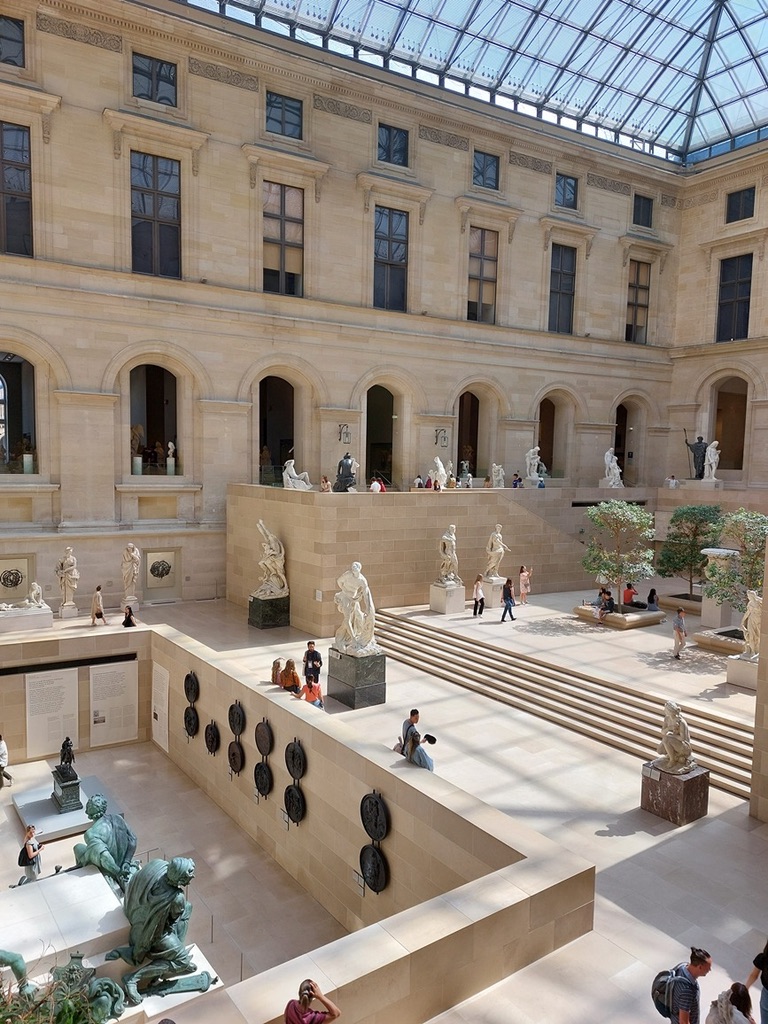
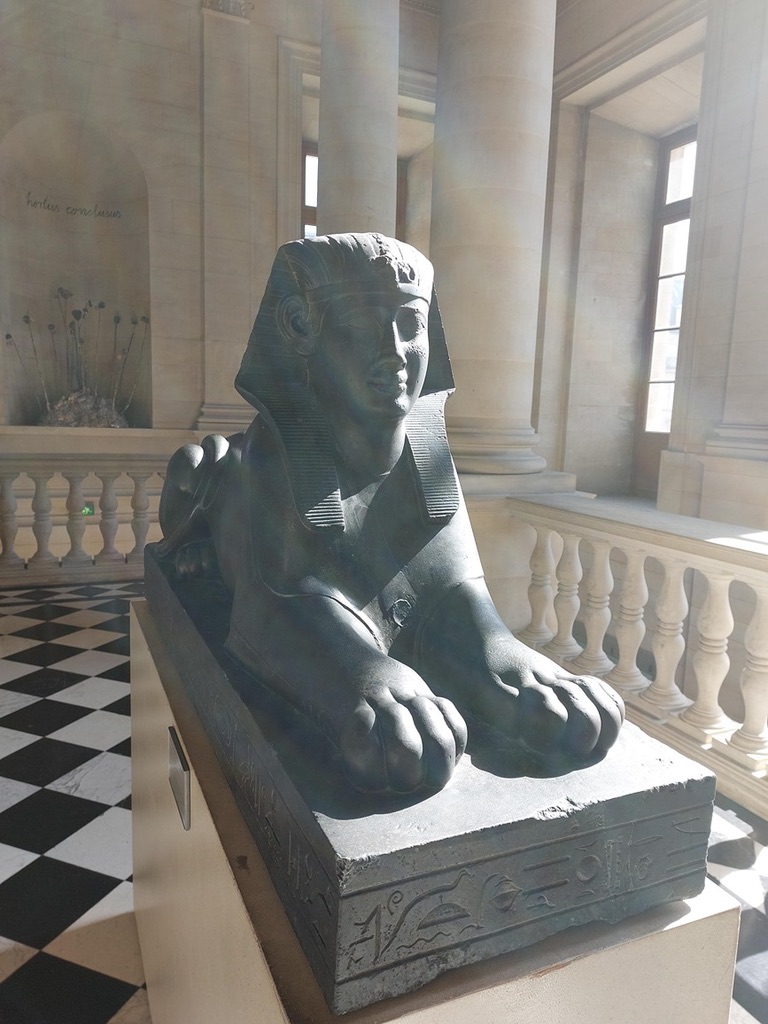
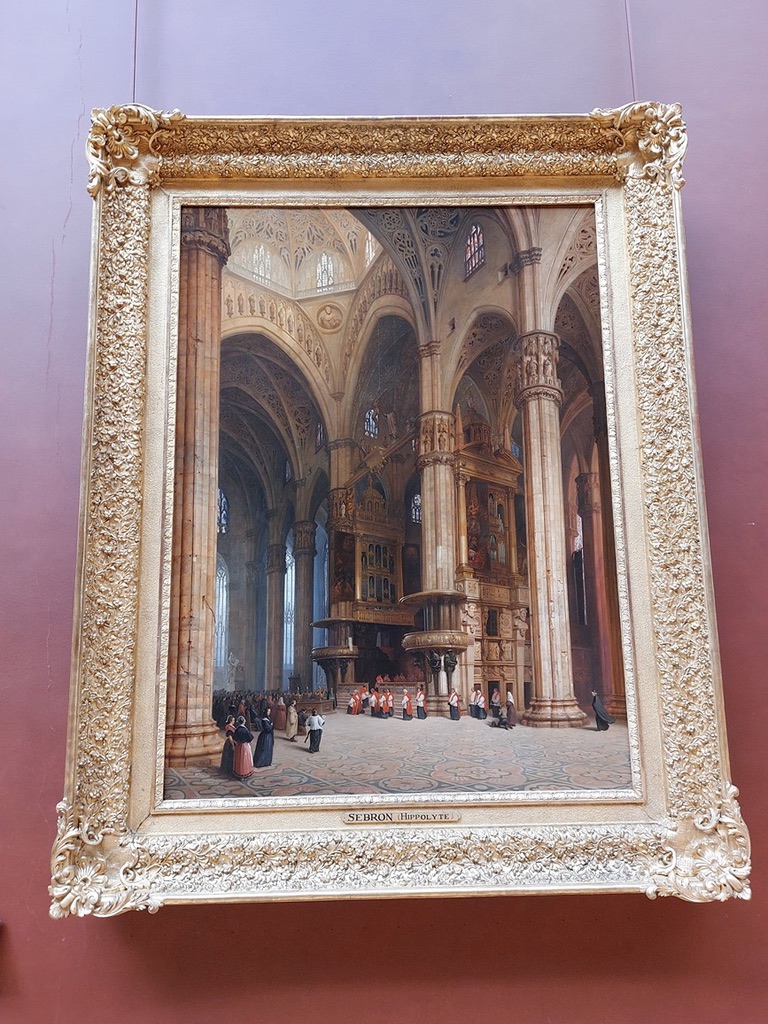
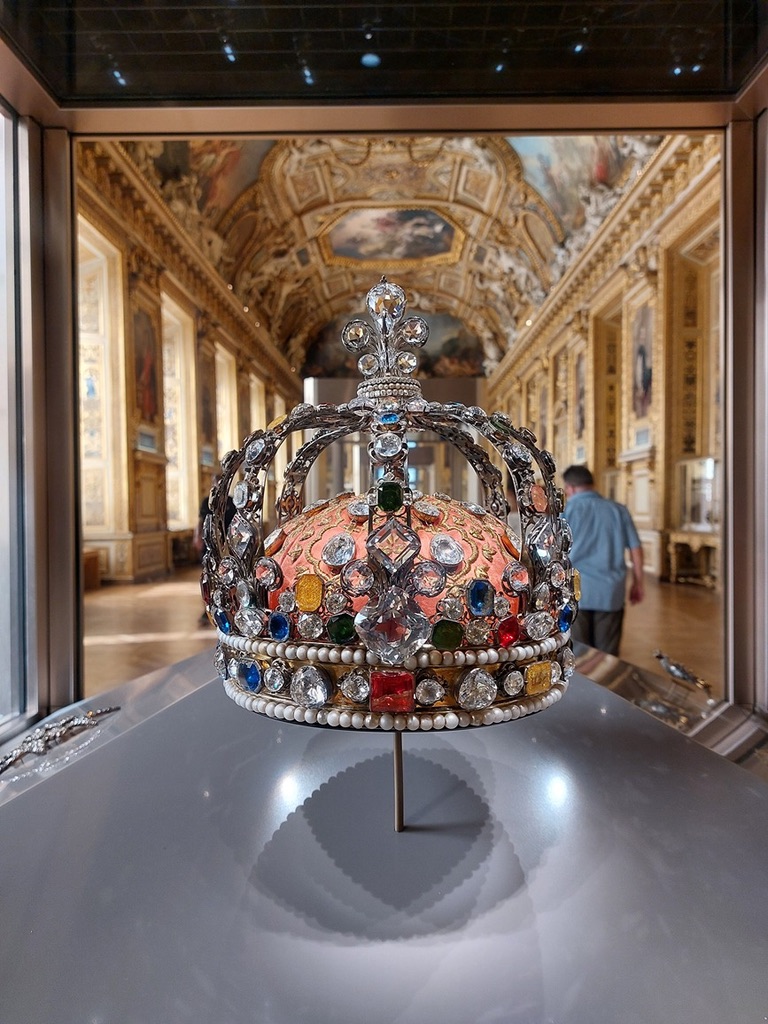

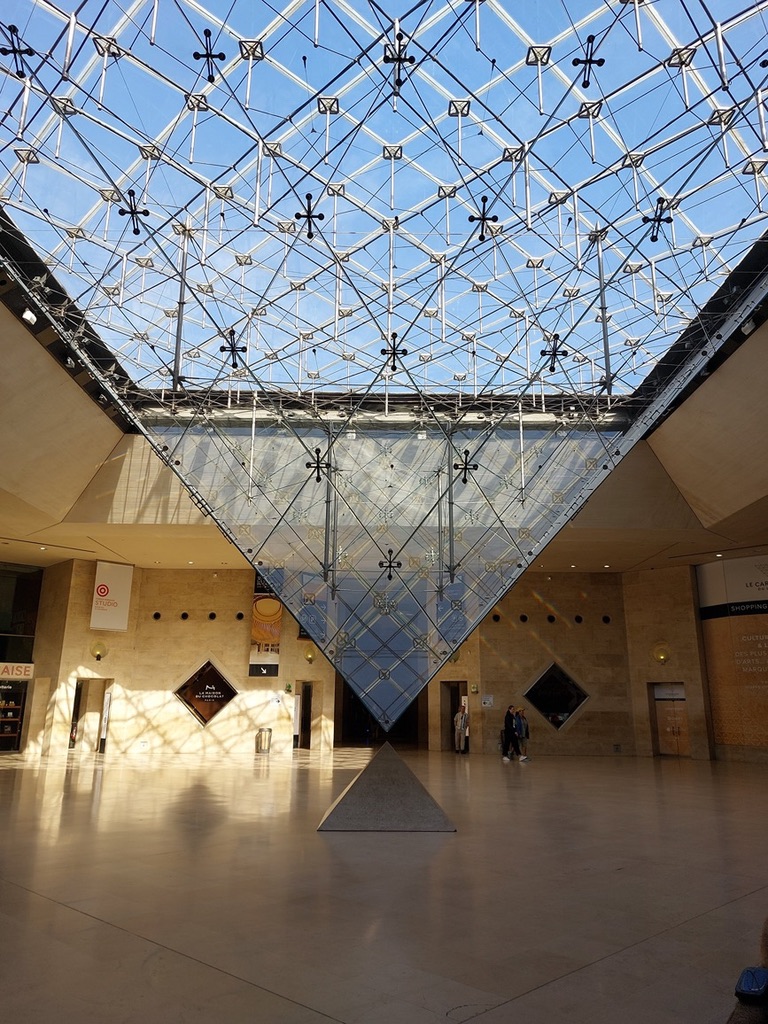
A large museum, with its own rules
TravelTips: Because The Louvre’s Art collection is sooo enormous it’s best – if you plan to go without a guide – to study the museum beforehand. You can do that online, through the following link: Louvre Museum Map.
- At the Louvre, you can take the main entrance at the Pyramid (What most people do, including many tour-groups). Alternatively though, you can take the Carrousel du Louvre entrance (through the underground mall), which generally is less busy. However, to be able to enter through the Carrousel you need to Buy your ticket in advance.
- Another way to gain time is to get up early. The Parisians are late risers anyway and it’s a real treat to venture the streets & parks early mornings (let’s say, between 7-9 am). This way you can be at the Louvre – and any other museum or attraction – before the crowds arrive. Get in faster & visit the highlights of the museum before everybody else does – like Da Vinci’s Mona Lisa.
* IMPORTANT: The Louvre provides free entrance for people under 18 & and for EU-residents between 18-26 years of age. As well as for people with a disability & one accompanying person.
Daily opening hours of the Louvre are from 9 AM to 6 PM. Important to know though, the museum is closed on Tuesdays & opens longer every Friday, 9:45 PM.
- The last tip for the Louvre must be common knowledge by now, but you never know. Because of the millions of visitors every year, it’s highly recommended to Buy entrance tickets beforehand. That means buying them online to gain time, but also to be sure you may enter, certainly during the busiests months, June-August & December.
To buy your tickets in advance, click on: Entrance tickets to the Louvre Museum
Or, if you like, a guided tour (English) of the museum’s highlights, go to: Guided Tour of the Louvre

Other Art museums in Paris
Besides The Louvre, Paris has dozens of other museums. The majority are Art Museums as well.
One of the famous ones, is the Musée Rodin. Housed in a beautiful 18th century mansion & garden, it’s principally dedicated to the work of Auguste Rodin. His famous sculptures are at display there, of which The Thinker & The Kiss are probably the best known.
Another popular museum is the Musée D’Orsay, which is located within walking distance from the Rodin Museum. This museum is dedicated to art collections of the 19th & 20th century. Exhibited in a beautiful setting, namely a former railway station.
TravelTips: * Both museums provide free entrance for people under 18 & and for EU-residents between 18-26 years of age. As well as for people with a disability & one accompanying person.
Other attractions in the vicinity of the Louvre museum:
Within walking distance from the Louvre – if you still have feet left! – you’ll find the Jardin des Tuileries. As well as, the Place de la Concorde, Petit & Grand Palais, Place Vendôme, Tour Saint-Jacques, Pont Neuf & Centre Pompidou.
A visit to the Sacré Cœur & Montmartre, Paris
Central in the Paris’ district of Montmartre stands the beautiful Basilique du Sacré Cœur (“Sacred Heart”). Located on top of the Butte Montmartre. The highest hill in the city center of Paris.
- The Sacré Cœur was built between 1875 and 1914. However, the inauguration was postponed until 1919 because of World War I. One of its main features is the bright, shining whiteness. Caused by the limestone (travertine) that was used to build the church, including the dome which seems to reach to the heavens.
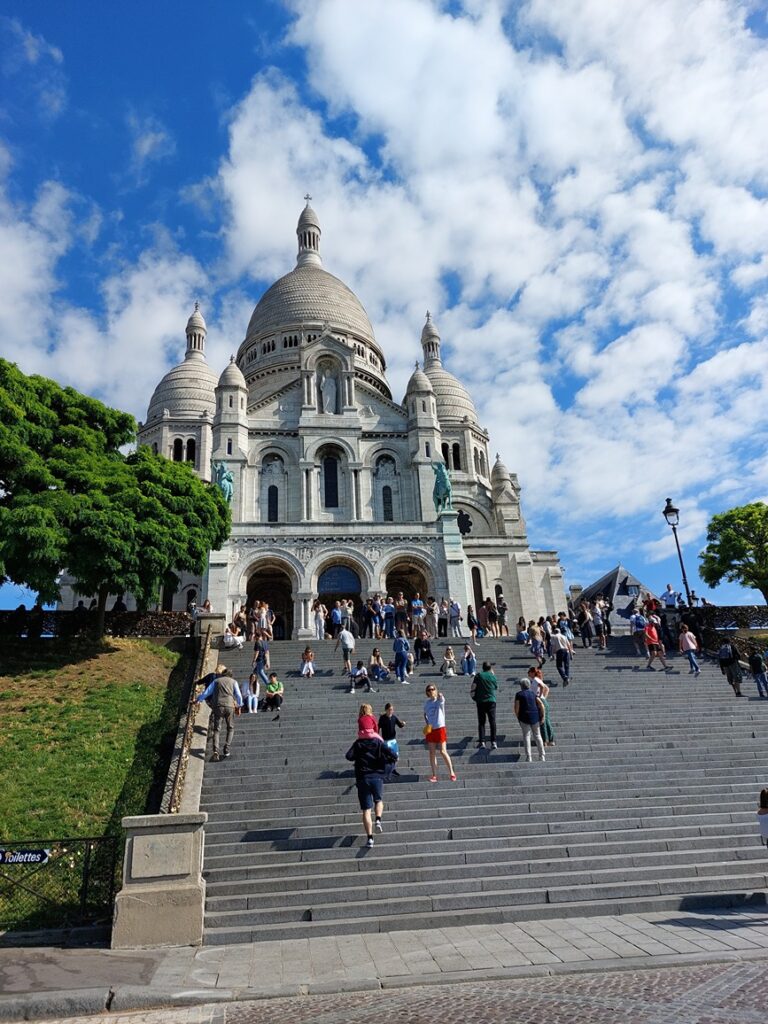
Together with the neighbourhood around – Montmartre – the Sacré Cœur is another highly popular tourist spot in Paris. Traditionally known for its bohemian vibe.
- A unique atmosphere that’s still in the air, but passed its zenith in the second half of the 19th century when many famous artists lived there. Mainly painters like Monet, Renoir, Degas, Toulouse-Lautrec, Van Gogh (& later on Picasso, Mondriaan & many others).

You can walk this historical neighborhood on your own, or learn all about it on a guided tour.
To learn more, click on: Walking Tour Montmartre/Sacré Cœur
Alternatively there’s also a heavenly “delicious” food tour in Montmartre.
To learn more, go to: Montmartre Cheese, Wine & Pastry tour





Impressions of the Montmartre Food Tour.
Other attractions in the vicinity of the Sacré Cœur/ Montmartre:
Montmartre is an ideal spot for people who want to enjoy nightlife. There are many exclusive bars & restaurants, as well as theaters & cabarets. The most famous one in the Red Light district is the Moulin Rouge on the Boulevard de Clichy.
Other attractions in this neighbourhood are the Place du Tertre, the Wall of Love (Le mur des Je t’aime, to sound more romantic) & the Musée de Montmartre (former home of Renoir & other painters).

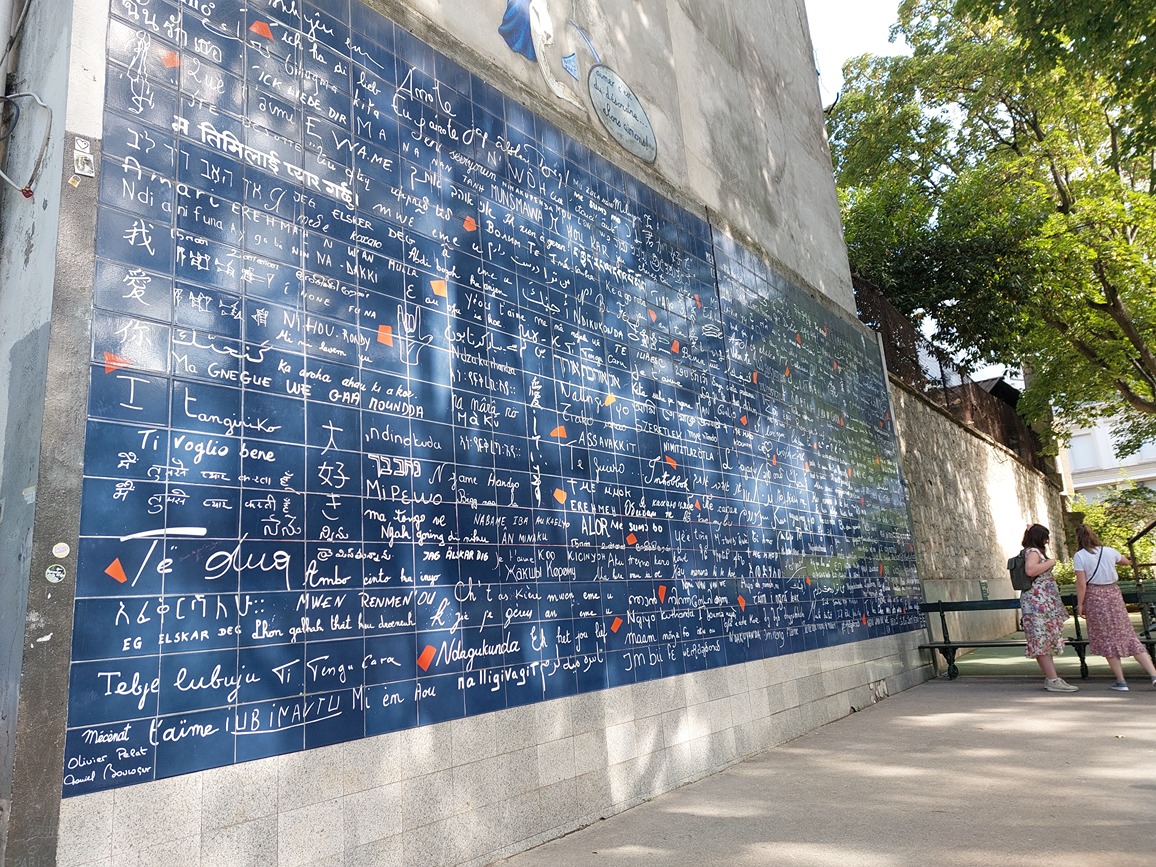
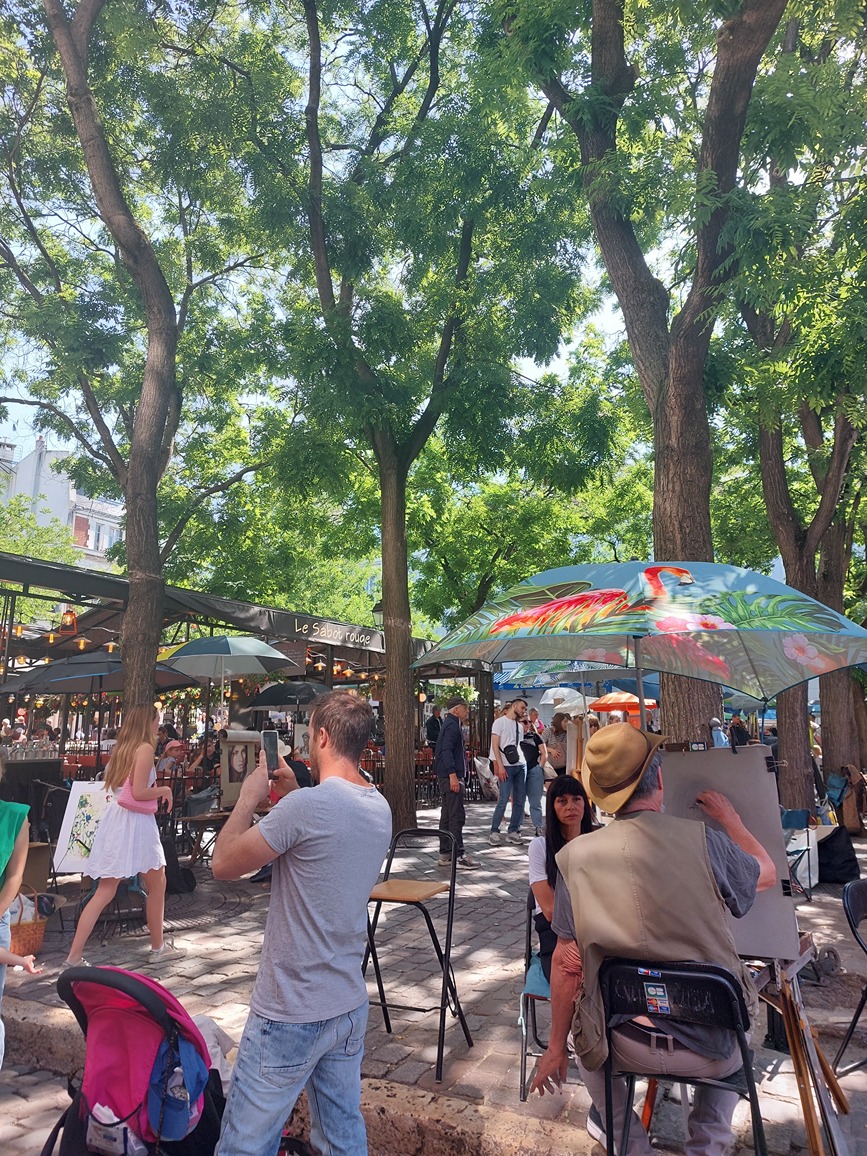
TravelTips: If you don’t feel like walking uphill (130m high) there’s a funicular which – for a few euros – brings you to the top in less than 2 minutes (the ride is included in a metro day-ticket). You can also take the funicular to return to the foot of the hill, but most people walk down.
- That said, most attractions, like museums, are friendly for people with a disability. Outside of these tourist spots though, there’s still a lot to improve in the city of Paris. Too many stairs, few ramps for wheelchairs, small cobblestones everywhere & other obstacles.
Plan beforehand how to get around and – when able – be prepared to walk a lot. Consider bringing or buying some comfortable walking shoes.
Concerning dress code. Don’t worry too much. In Paris you can wear whatever you like. That is, shorts, a sweater/t-shirt, and even slippers (although as stated above, the latter are not suitable on cobblestones, nor when visiting old churches & other monuments).
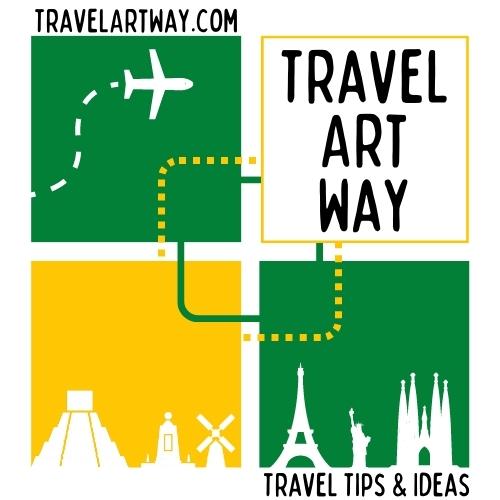
TRAVELTips: On Personal Safety in Paris
WARNING! Because a visit to the Sacré Cœur & Montmartre is one of the most popular things to do in Paris, it’s always busy. Too busy sometimes really, with visitors and “sellers”.
As a consequence, there’s a lot of petty crime as well. As around every major attraction in Paris & other popular destinations worldwide.
First of all, always be aware of pickpockets. Don’t carry too much money around & other personal belongings. Be aware of your mobile phone, photo camera, amongst other things.
Secondly, be aware of other tricks to steal your money and/or your personal belongings.
Fashionable tricks
- An often heard trick nowadays is young people – boys & girls – who ask you to support a charity. Poor children in Africa. Save the whales. Help for war victims. All good causes, but BE CAREFUL. Often they ask you (nicely) to sign a petition first, which – when you do – obliges you to pay them more than you initially wanted to pay. (In some cases, these youngster even stole innocent victims wallets or other personal items.)
- Another trick is to stop you in the street & put a souvenir-bracelet around your wrist. A movement the “sellers” perform so quickly & in such a way – that is, so tight – you can’t get it off, and you have to pay them & pay too much. Something which – again – mostly happens in busy areas, like the area around the Sacré Cœur.
- Lastly, an often heard complaint of unaware tourists in Paris is getting overcharged for hiring a bicycle taxi (“tuk-tuk”) or horse-drawn carriage. Instead of paying the pre-agreed price for the ride, the operator – at the end of the tour – insists the amount agreed upon applies to every individual in your group.
Surely there are many other tricks, but these are the most “popular” ones anno 2024.
The best you can do: STAY ALERT!!!
That said, Paris overall is a safe city. Even in public transport, like the metro. Just be aware always of your surroundings, be careful.
A Cruise on the Seine, Paris
During the Third Century BC a Celtic tribe – the Parisii, settled on the banks of the Seine…” So the foundation story goes. A city was born, the first people settled on the little island – nowadays known as the Île-de-la-Cité – located in the middle of this legendary Paris river.
- Although Paris at the time still had to pass a Roman period under the name of Lutetia, it got its actual name in the 4th Century AD.
* BookTip: If you’re interested in the City of Light’s past, we can highly recommend Edward Rutherfurd’s Paris, the novel.

Nowadays the Seine is one of the “trademarks” of Touristy Paris. Not per se for a swim, but yes for a sightseeing boat cruise.
TravelTips: A popular thing to do during daytime, but also in the evening (if you wish, including a fancy dinner). A river tour around the island, under a few of the famous central bridges – like Pont Neuf – and along some of the most famous Parisian monuments, like the Eiffel Tower, Notre Dame, the Louvre & others.
To learn more, go to: Seine Cruise Paris

TRAVELTips: Give me a break…
When you compare a cruise on the Seine with most other attractions, the biggest difference is the energy you have to put into it. For that reason, it’s a great way to take a break from an energy-draining city like Paris.
That said, we would recommend you – while planning your visit to Paris – to incorporate a resting point once in a while. Paris has some beautiful parks & squares spread throughout the city. In most parks you’ll find chairs and/or benches to rest on. Or else, you may lay down on the grass for a while or even have a picnic (depending on the season of course).
To name a few Top Parks in the inner city: Luxembourg Gardens (Latin Quarter), Tuileries (near the Louvre), Champ de Mars (Eiffel Tower) & the Botanical Garden (Jardin des Plantes).
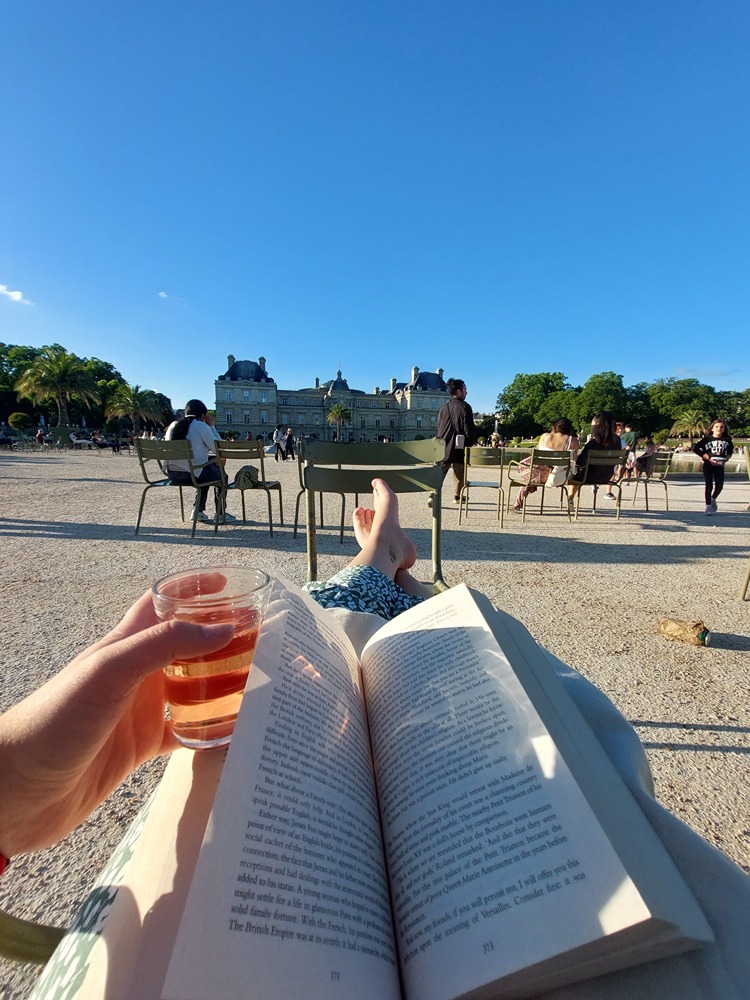
*****
Unsurprisingly, the center of Paris is full of bars & restaurants. Terraces everywhere. Although generally expensive, it’s still possible to find cheaper alternatives just outside of the most popular tourist areas.
On tipping & ordering
When it comes to tipping waiters & waitresses … This service is normally included in the price, but that doesn’t mean you can´t give a tip to a professional & friendly one (preferably in cash).
Concerning language. More and more Frenchmen & women in the tourist sector attend tourists in English. That doesn’t mean they always do so automatically. The best tip we can give you is to learn a little bit of French. At least to be able to order a drink or a snack. Surely, it will be appreciated, and help you to enjoy Paris even more. You would be surprised what a simple “Bonjour” or “Merci” can do.

Other THINGS TO DO in Paris, France – The Hidden Gems
After introducing the most visited attractions, we want to inform you of other ones Paris has to offer. Although less popular, this doesn’t mean they are less beautiful or interesting. In fact, for many visitors these lesser-known attractions are the ones that stick out the most.
Real HIDDEN GEMS you have to learn about before you visit Paris.
A visit to the Opéra Garnier, Paris
The first monumental attraction we want to mention is the Opéra Garnier. Also known as the Palais Garnier. Talking about … a hidden gem!
- Construction of this Opera House was started during the Second Empire, in 1861, and finished in 1875, five years after the reign of Emperor Napoleon III had ended. The opera is named after its architect, Charles Garnier.
It served as an Opera house as recently as 1989, when a new one opened nearby – the Opéra Bastille. Nowadays, the Opera Garnier is still used for performances – mainly ballet – but it’s foremost another Paris attraction you can visit.
- The Opéra Garnier was the setting for the world famous novel The Phantom of the Opera, written by Gaston Leroux.
Although maybe not to everyone’s taste, most visitors find the opera an astonishing, beautiful & mesmerising place. On the outside & the inside. For some it became the “favourite monument” they visited in Paris.
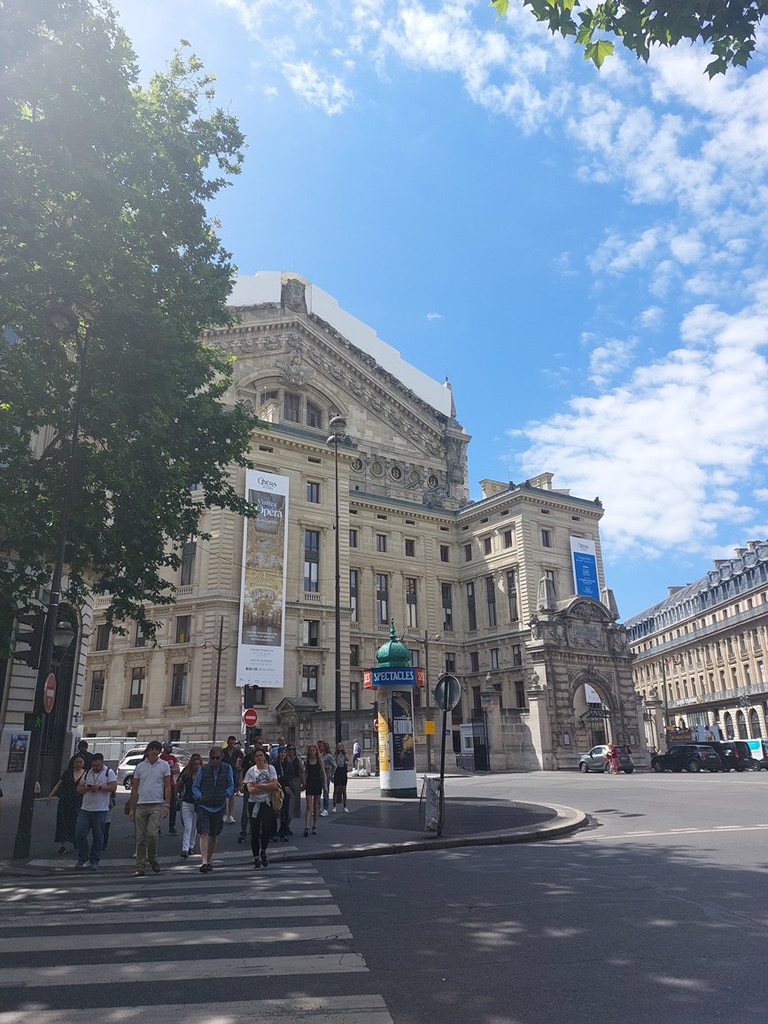
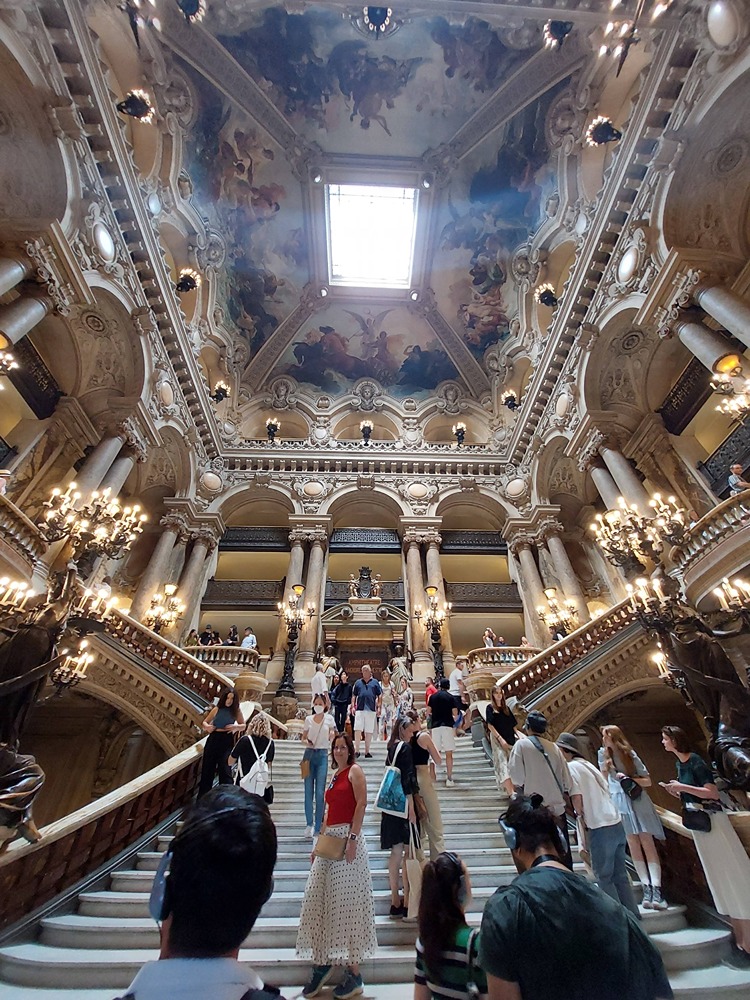
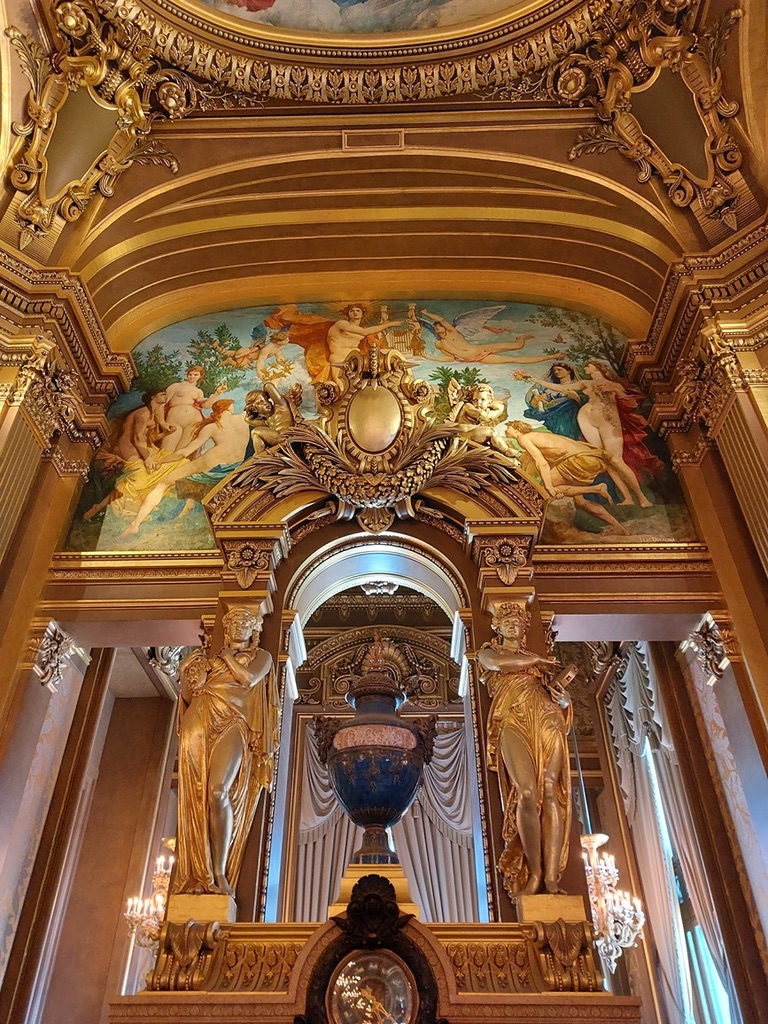
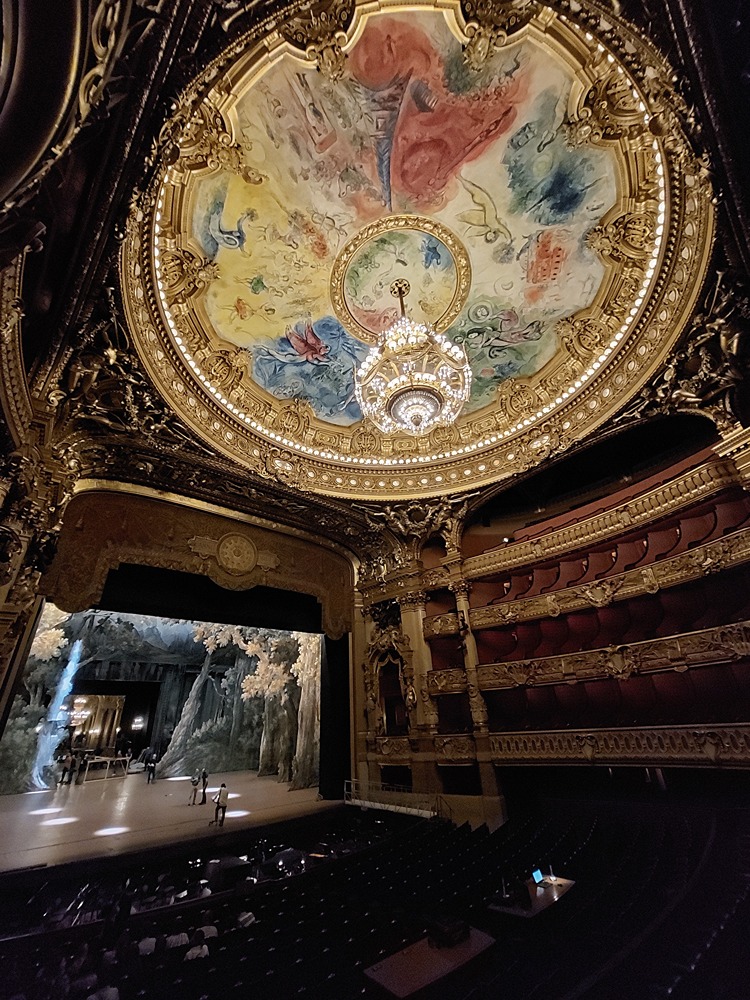
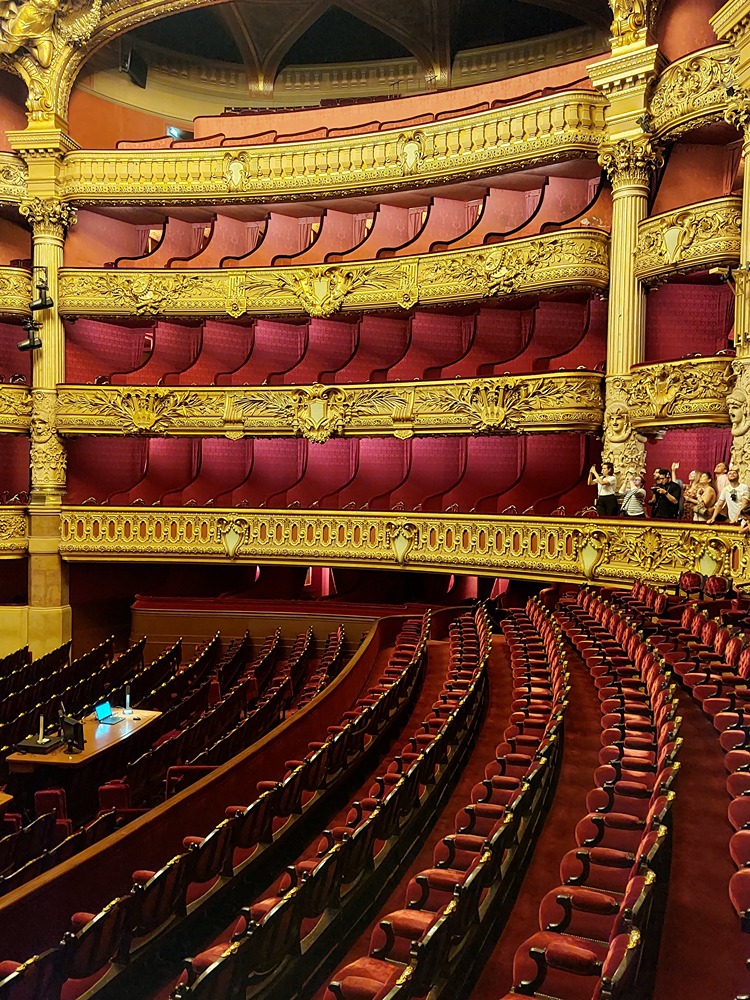
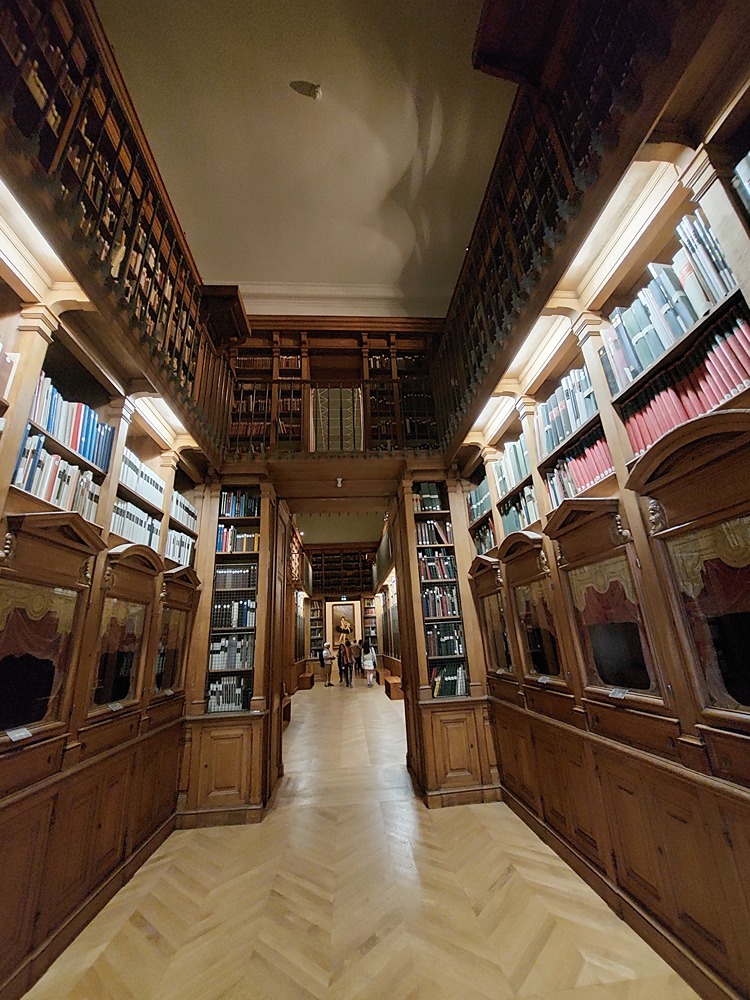
TravelTips: The opera is open to the public, from 10 AM until 5 PM (during the high season, until 6 PM). Be aware though, the Opera sometimes closes its doors when there are daytime performances.
You can freely walk around the opera: up- and downstairs, on the stage (front & back), the vestibule, the balconies. As well as visit the beautiful library, the Bibliothèque-Musée de l’Opéra Nacional de Paris.
* The Opéra provides free entrance for people younger than 12. As well as for people with a disability & one accompanying person. Younger people, between the age of 12-25, can enter for a reduced price.
* Click here for: Availability of Tickets & Prices.
Other attractions in the vicinity of Opéra Garnier:
Nearby – a few minutes walk – you can find two historic department stores: the Galerie Lafayette & the Printemps Hausmann (both with an observation deck & terrace). Also located very near the opera is the L’Église de la Madeleine.
Visiting Sainte-Chapelle, in the heart of Paris
Another hidden gem is the church of Sainte-Chapelle, on the Île-de-la-Cité – the City Island in the Seine.
As the Opéra Garnier, this church is generally not an attraction you encounter in most visitor’s Top 3 – or even Top 5 – of Things to Do in Paris.
- The chapel was originally part of the Royal Palace, where the earlier kings of France lived. It was built under King Louis IX and inaugurated in 1248. Finished in only seven years.
- It was mainly built to house the religious relics the mentioned king had gathered during his lifetime: Christ’s Crown of Thorns, a fragment of the cross, a nail & many others.
- These relics were kept in the chapel until the French Revolution. In 1801 the revolutionaries moved them to the Notre-Dame, where they stayed until recently. On April 15, 2019 they were rescued by the Paris Fire Brigade and returned to Sainte Chapelle.
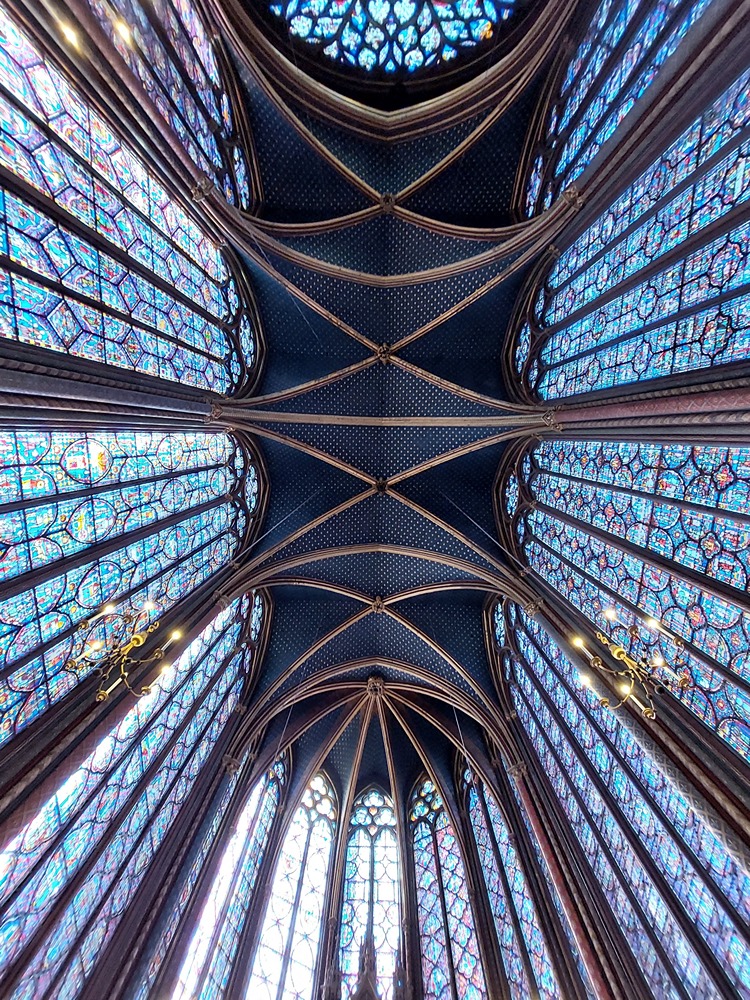
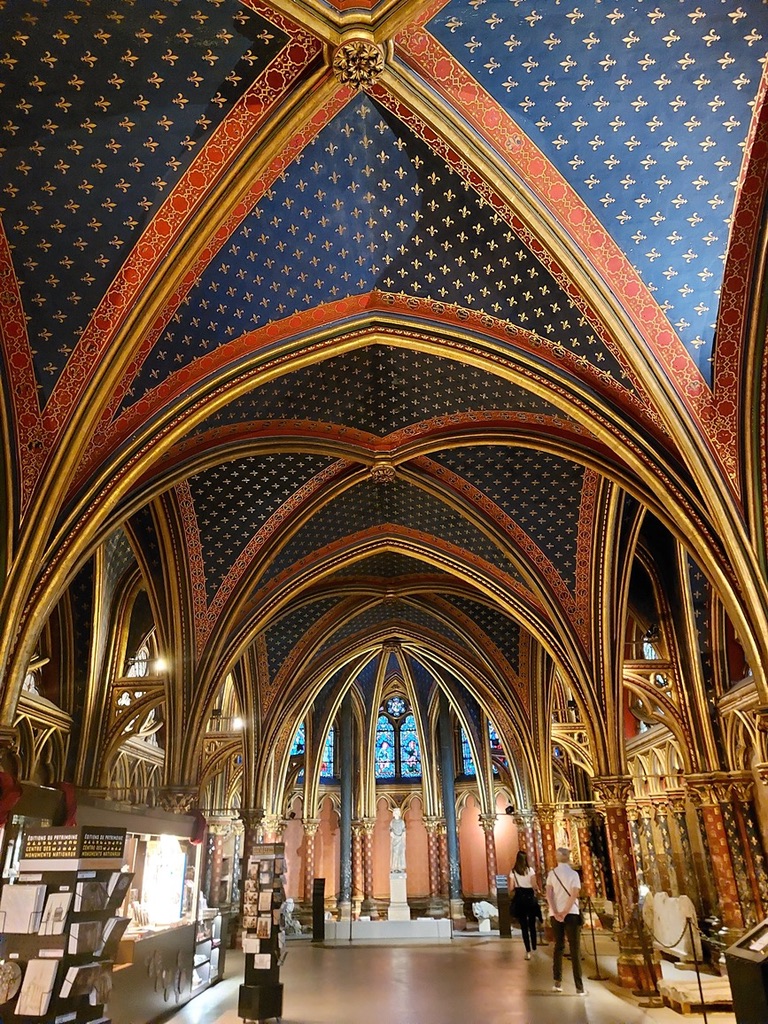
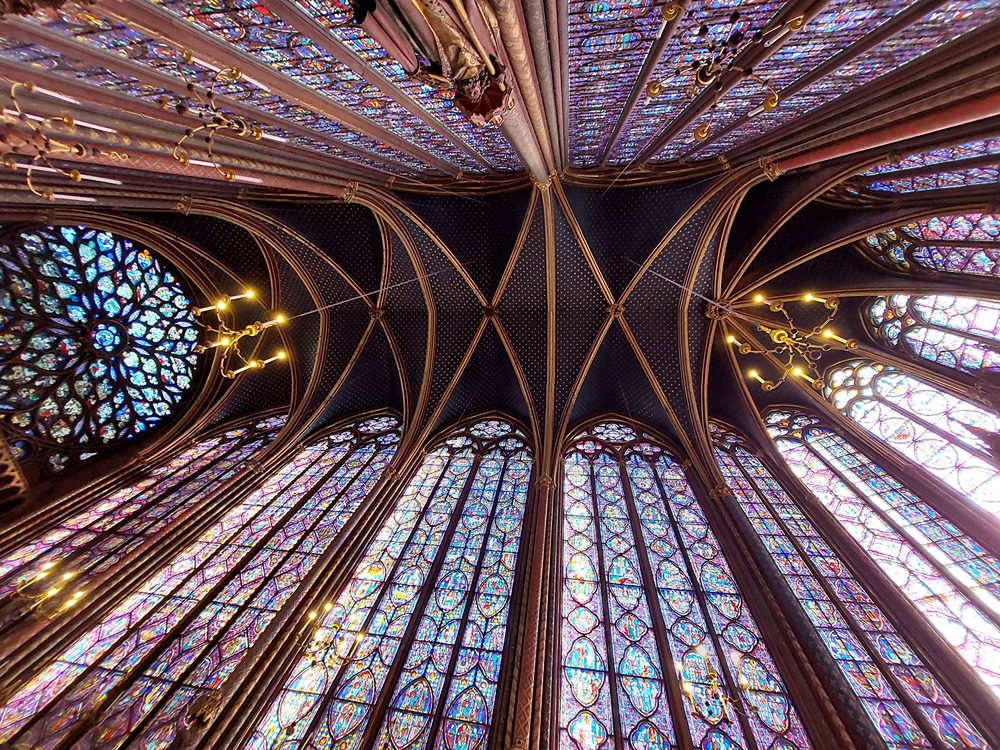
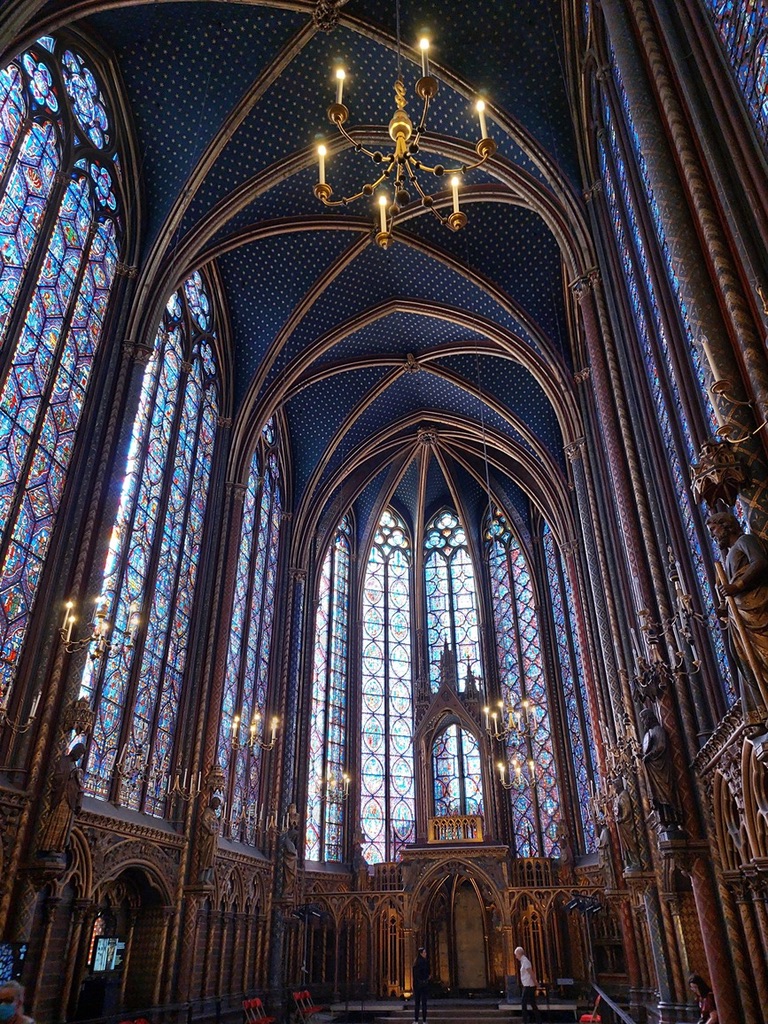
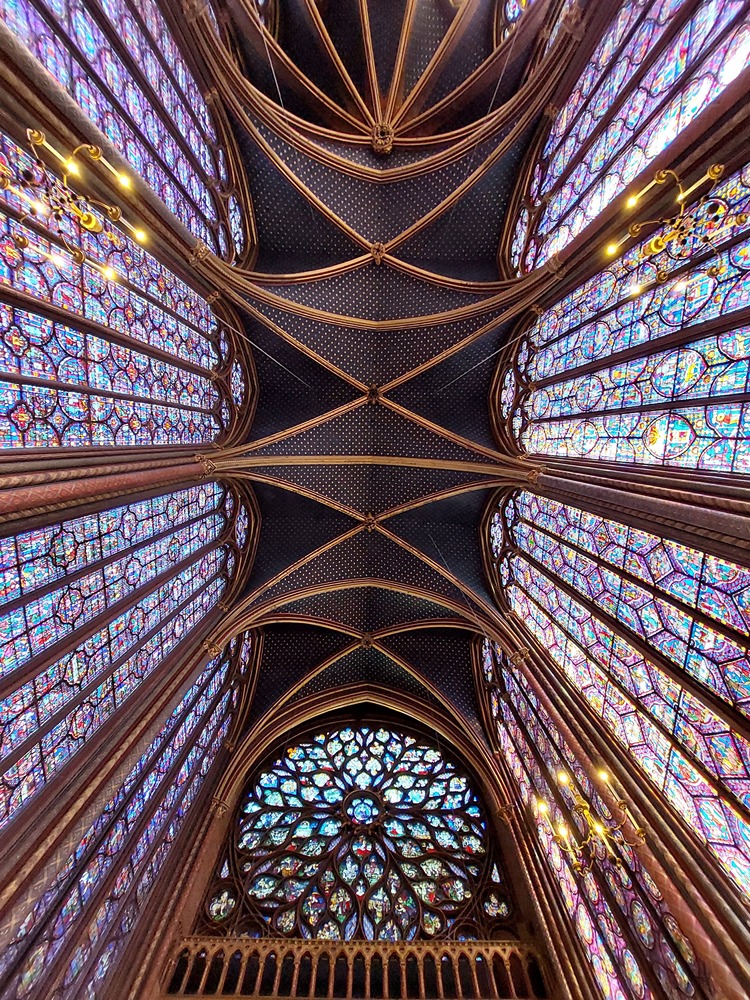
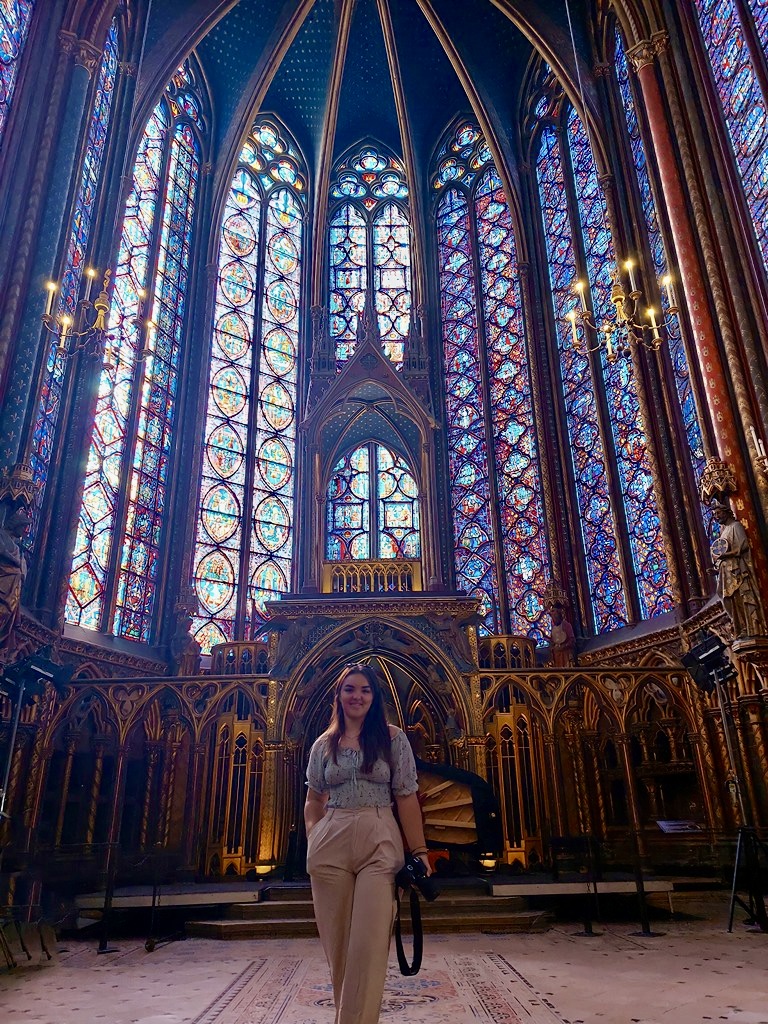
The stain-glass windows
Although, as said before, Sainte-Chapelle isn’t one of the top attractions of Paris, every day hundreds of people visit the church. Because of its Gothic beauty, the relics we mentioned, as well as the churches’ stained-glass windows, giving the interior a magical touch.
- There are 15 stained-glass windows in all, 15 meters high, showing a total of 1.113 scenes from the Old & New Testament. Most stained-glass windows date back to the 13th century.
- Another remarkable feature to watch for in the Sainte-Chapelle is the fact there are actually two different chapels. The lower chapel, originally dedicated to the officers & the upper chapel, dedicated to the Royal family.
* Sainte-Chapelle provides free entrance for people under 18 years. As well as for visitors aged 18-25, being a resident of the EU, and people with a disability & one accompanying person.
- A visit to Sainte-Chapelle is often combined with other attractions nearby like a tour of the Île-de-la-Cité and/or the Conciergerie (see below).
To learn more, click on:
Other attractions in the vicinity of Sainte-Chapelle, Île-de-la-Cité:
Besides the mentioned chapel, other major attractions on the island are the La Conciergerie, the Notre Dame (see below), the Deportation Memorial. Just across from the Notre-Dame – but on the other side of the Seine – you’ll find the Shakespeare & Company Bookshop & Cafe.
- The Mémorial des Martyrs de la Déportation is a monument which commemorates the two-hundred thousand men, women & children who were deported from Vichy-France to the concentration camps of the Nazis during the Second World War.
A visit to La Conciergerie, Paris
Neighbouring Sainte-Chapelle is a palace called La Conciergerie. Originally it was also part of the Royal Palace.
- Until the end of the 14th century la Conciergerie was the residence of the kings & queens of France. Afterward, it became the Paris courthouse & prison.
- During the French Revolution thousands of political opponents were imprisoned here. The most famous prisoner being the former Queen Marie-Antoinette. Amongst others, like the revolutionary Maximilien Robespierre & the last Emperor of France, Napoleon III.
- Marie-Antoinette’s cell is open to the public & for many visitors the main attraction of the Conciergerie.
Travel Tips: As for the Sainte-Chapelle, it’s recommended to buy tickets in advance.
It’s IMPORTANT to know though, that La Conciergerie also provides free entrance for people under 18 years. As well as for visitors aged 18-25, being a resident of the EU, or for people with a disability & one accompanying person.
To learn more, click on:
Visiting the The Notre-Dame, Paris
Another – more famous – Gothic church is the nearby Cathédrale Notre-Dame de Paris.
- Its construction started much earlier than the Sainte-Chapelle, but was finished twelve years later.
As you surely remember, the Notre-Dame was heavily damaged during a fire in April 2019. A fire that started in one of the attics, but which in the end caused major damage to the roof & spire. Reason why – until today – the cathedral is closed to the public.
- The latest news though is, that the Cathedral will open its gates again on December 8 2024.
TravelTips: As a small consolation though, you can still admire this impressive church from the outside.
Alternatively there’s the possiblity to visit to the Notre-Dame virtually near the monument itself.
* To learn more about this unique experience click on: Eternal Notre-Dame VR Experience
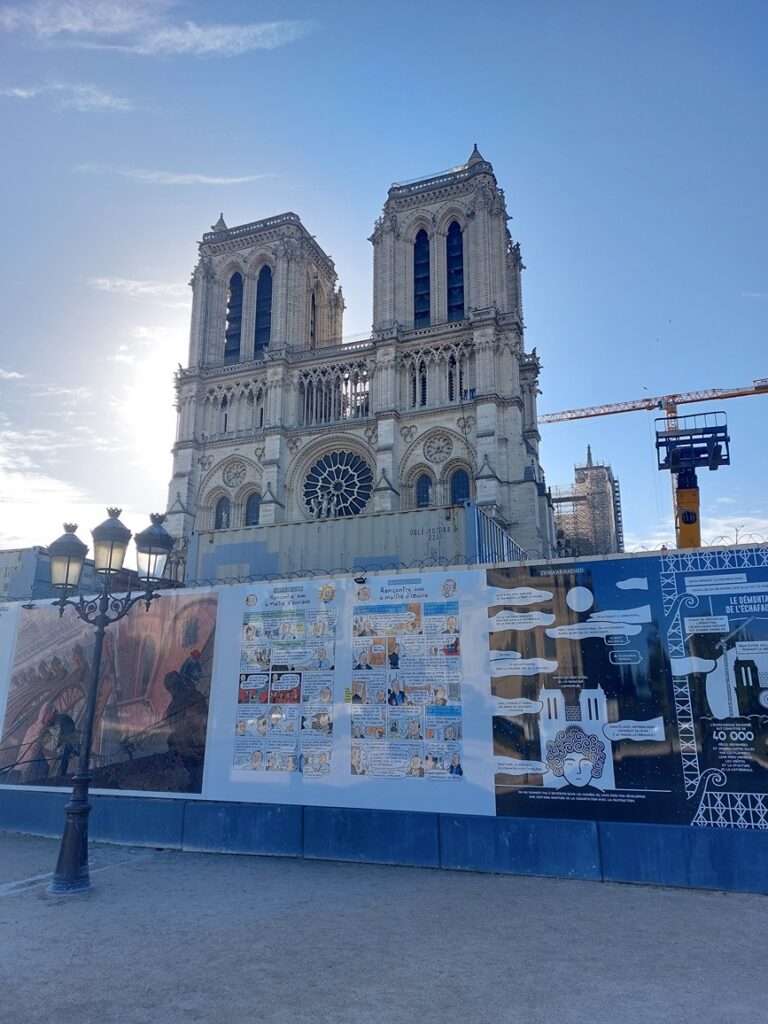
Or else, you can take a guided tour of the City Island, along the Notre-Dame, with actual visits to the Sainte-Chapelle & the Conciergerie (see above).
* To learn more, click on:
As you will notice – while visiting the Île-de-la-Cité – the island is an attraction in itself. A romantic part of Paris with a long … long history. A nice break near the island is provided by the earlier mentioned Shakespeare & Company bookshop, which features a cafe & terrace with a nice view of the Notre-Dame.
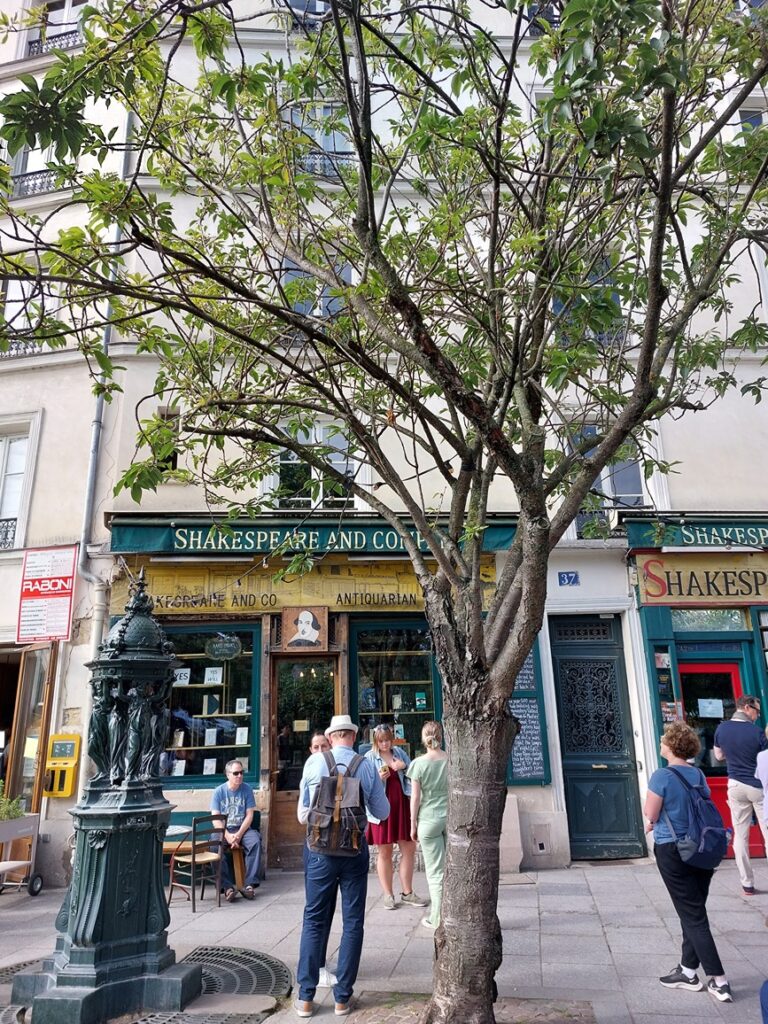
A visit to the Basilique Saint-Denis, Paris
The last Gothic church we like to mention is the Basilique Saint-Denis. Located a little to the north of Paris’ city center.
- Saint-Denis is actually the oldest Gothic construction in the world. Originally built as an abbey, Saint-Denis was inaugurated in 1144, little over a century before the Sainte-Chapelle.
- Saint-Denis is the resting place for no less than 42 former kings & 32 queens of France. Among them, the famous couple King Louis XVI & Queen Marie-Antoinette, executed in 1793 during the French Revolution. But also the burial place of Louis IX, who originally got the idea to build the Sainte-Chapelle.
* To learn more, click on:
TRAVELTips: Concerning the weather in Paris
The climate. Although always unpredictable – more so, the last couple of years – Paris usually has its hottest months in July & August (Average (min/max): 16-26C/61-79F). The coldest in December/January (3-8C/37-46F).
Also important concerning the weather: Paris has 4 seasons . It’s located almost 50° North of the Equator. As a consequence in July/Augustus you can enjoy around 15 hours of sunlight. In Winter only around 8.5 hours.
Finally, rain… Rain can fall every day, in every month. Be prepared, when you pack your bags for your visit to Paris. Fortunately the French capital is always beautiful. During every season, warm or cold, windy, rainy or tropical hot.
Visiting the Panthéon, Paris
Another monument that for most people stands in the shadow of the Eiffel Tower, the Louvre & the Sacré Cœur, is the Panthéon. A Neoclassical building, located on the Montagne Sainte-Geneviève, a low hill in the Latin Quarter.
- The Panthéon was originally meant to be a church in honour of Sainte-Genevieve. King Louis XV commissioned it & construction started in 1758. However, when it was finished in 1790 the French Revolution was well on its way, and the revolutionaries decided to use the building as a mausoleum.
And that’s what it still is today. A mausoleum for France’s National Heroes – with exception of the highest military heroes, like Napoleon Bonaparte, who is buried in Les Invalides (see below).
- In the Pantheon you’ll find the graves of many famous people. To name a few: the writers Victor Hugo, Émile Zola & Alexandre Dumas. The philosophers Voltaire & Rousseau. The scientists Marie & Pierre Curie. The navigator & explorer Louis-Antoine de Bougainville, as well as the hero of the French resistance during the Second World War, Jean Moulin.
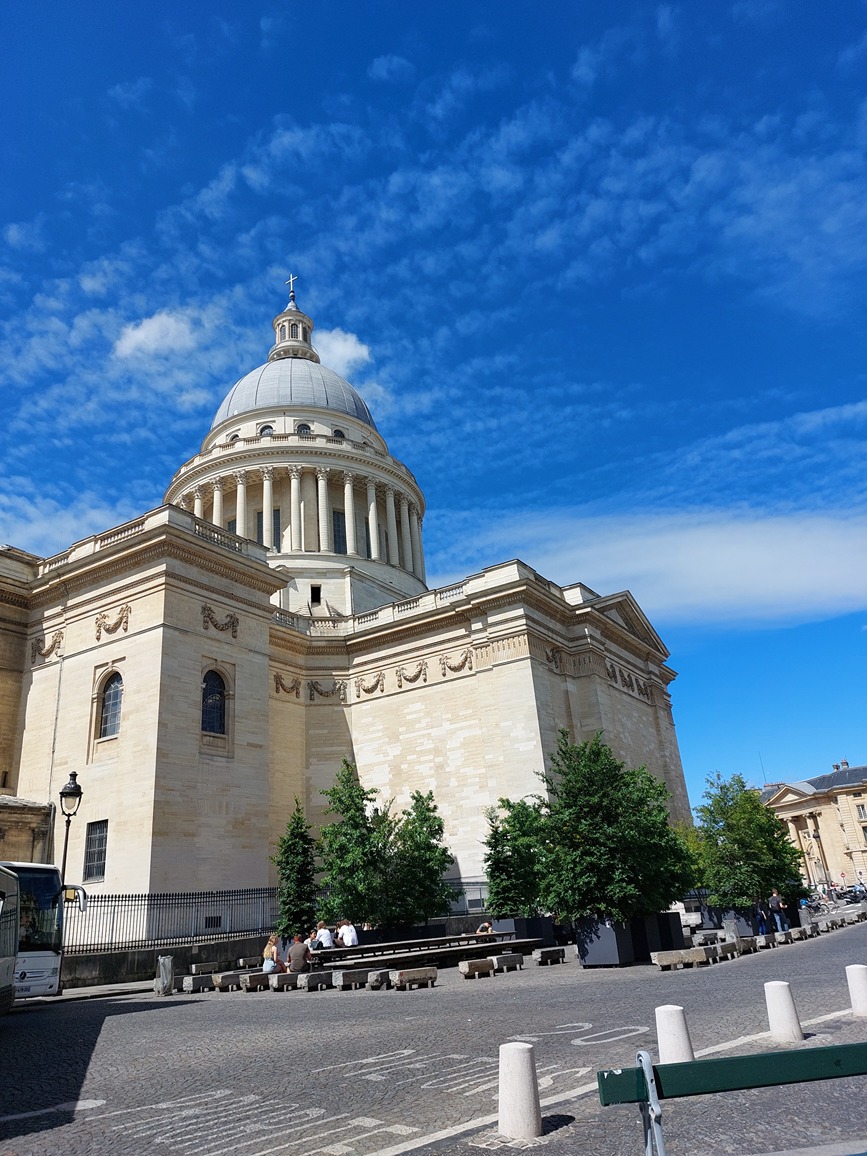
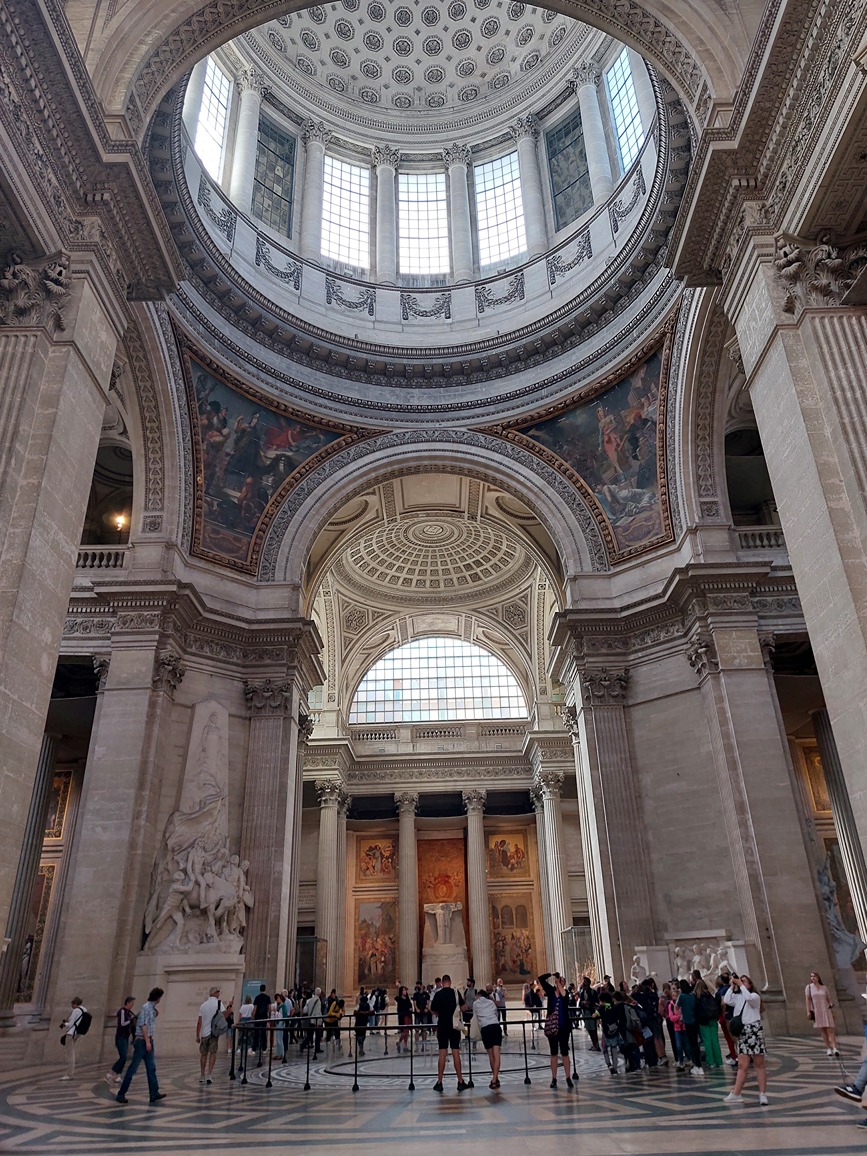
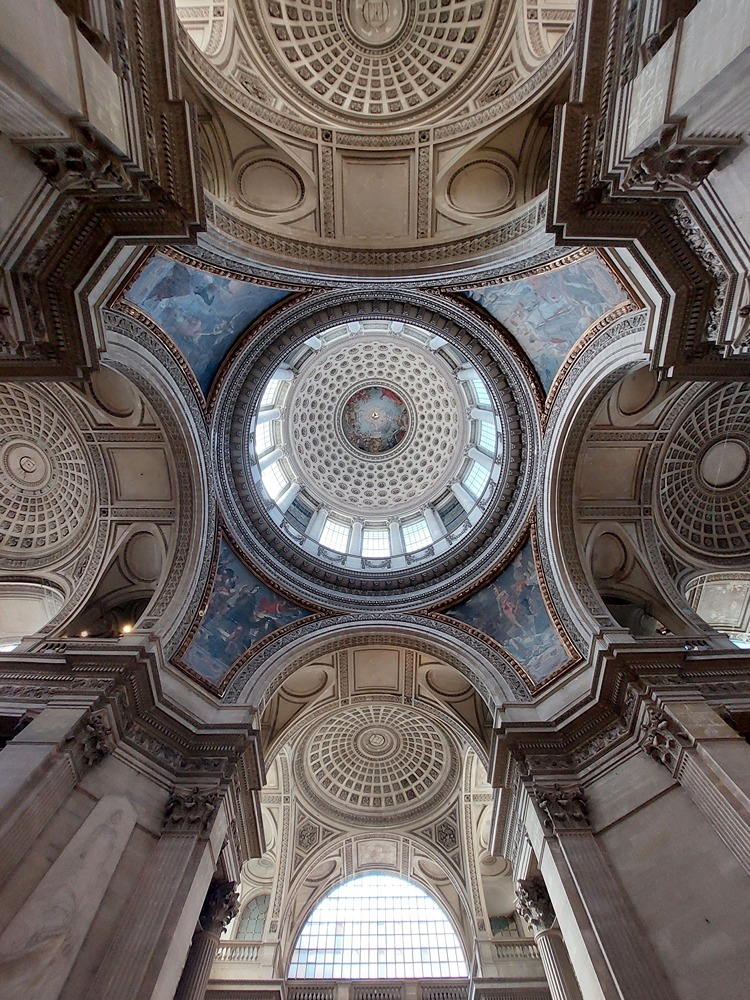
All in all, an impressive monument. Because of the gathering of so many celebrities, but also because of the building itself. A construction that is meant to make you feel small. Humble in the presence of so many famous & sometimes heroic people.
- Besides the stately facade, the Pantheon features a 83m/272ft high dome – which are actually three domes, one within the other – amongst many other remarkable features.
Absolutely worth a visit, when you’re walking the streets of the Quartier Latin in Paris.
TravelTips: The Pantheon provides free entrance for people under 18 years. As well as for visitors aged 18-25, being a resident of the EU, and for people with a disability & one accompanying person.
* To learn more, click on:
Other attractions in the vicinity of The Pantheon:
Near the Pantheon you’ll find the Luxembourg Gardens (Jardin du Luxembourg), one the most beautiful parks to visit in Paris. Also, the church of Saint-Étienne-du-Mont, the Roman ruins at the Arènes de Lutèce, the Botanical Garden (Jardin des Plantes), the Catacombs de Paris (see below) & the Musée de Cluny.
A little further away, but still within walking distance you can visit the Cemetery of Montparnasse.
- At the Montparnasse cemetery you’ll find the graves of many celebrities. Frenchmen & women, like the writers Guy de Maupassant, Simone de Beauvoir & Jean-Paul Sartre, the actor Jean-Paul Belmondo, the military officer Alfred Dreyfus & ex-President Jacques Chirac. But also the former Mexican president Porfirio Díaz, who died in exile in Paris (1915).
- One of the most visited celebrity-graves in Paris though, is the tomb of Jim Morrison at the Cimetière Père Lachaise. A cemetery where you can also find the last resting place of people like Édith Piaf, Oscar Wilde, Honoré de Balzac, Proust, Chopin & Napoleon’s most famous Marshal Joachim Murat. Near this graveyard, you can visit the beautiful, somewhat hallucinating – the first Digital Art Centre of Paris.
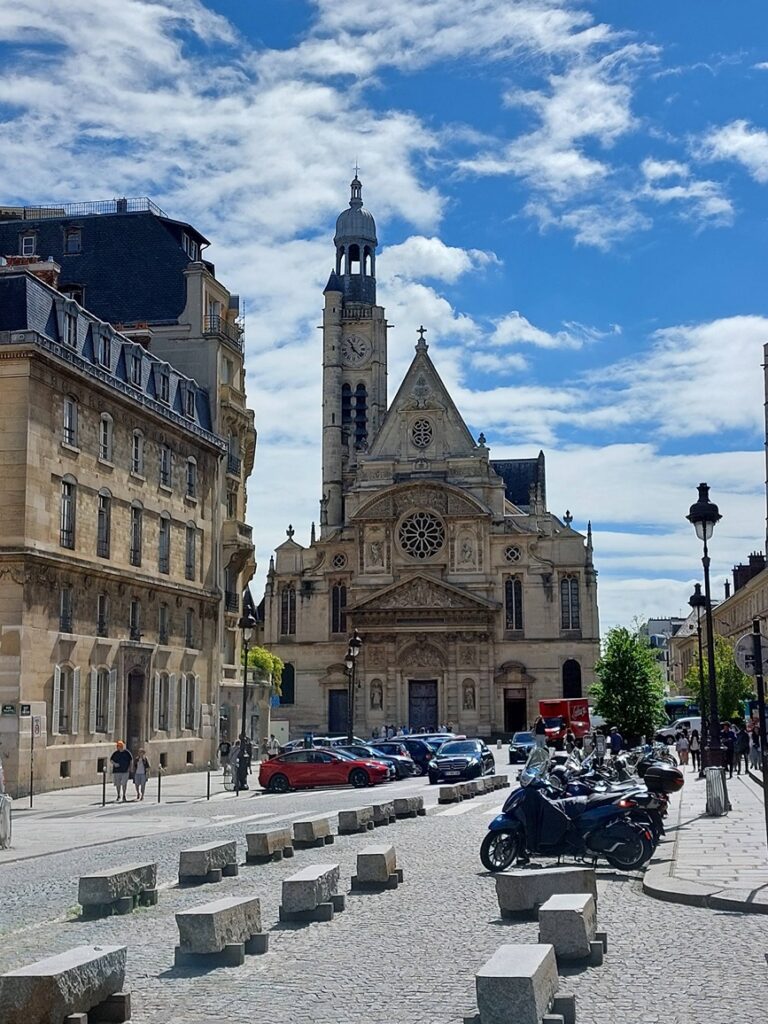
Catacombs de Paris – Empire of Death
A somewhat creepy, but simultaneously highly popular thing to do in Paris is to visit the city’s underground Catacombs – “l’Empire de la Mort”.
Actually a former stone quarry underneath the city center which was turned into an ossuary at the end of the 18th century. Holding the remains of millions of Parisians. Bones & skulls collected from the above ground cemeteries, which at the time were “overcrowded”.


Images of the Paris Catacombs underneath the city center.
Soon thereafter it was made possible for people to visit this mausoleum. It’s only since 2013 though that the Catacombs were converted into a museum. A museum which tells & shows you the history of this unique Dark spot underneath the City of Light.
TRAVELTip: As you may know, because of its popularity and the fact that only 200 people are allowed at a certain time to enter the Catacombs, it’s highly recommended to Buy your tickets in advance. Also because at certain times long lines can form in front of the ticket office.
To know if tickets are still available for the dates you’ll visit Paris, you can use the following calendar:
Other attractions in the vicinity of The Catacombs de Paris:
Within walking distance from the Paris Catacombs you’ll find the Panthéon & the Jardin du Luxembourg, one the most beautiful parks in Paris. Also, the Paris Montparnasse Observation Deck with spectacular views of the City of Light (including a prominent one of the Eiffel Tower).

To learn more on this last attraction, click on: Paris Montparnasse – Top of the City
A visit to Les Invalides, Paris
Tourists to Paris visit Les Invalides principally to have a look at the last resting place of Napoleon Bonaparte.
- Napoléon Bonaparte was born on the French island of Corsica. Although far away from the heart of France, he managed to climb the military & political ladder little by little. Mainly, because of his military victories. Remarkable victories who made him the mightiest man in the world, but in the end also meant his downfall. First on the frozen battlefields of Russia & finally at Waterloo, Belgium. He died in exile on Saint Helena (1821), a small island in the middle of the Atlantic Ocean.
Napoleon I for many Frenchmen & -women is still is the biggest hero. For that reason, you would think Les Invalides was specially built for him, but that’s not the case.
- Construction of Les Invalides started in 1670 under the reign of Sun King Louis XIV. He wanted Paris to have a home annex hospital for the old & handicapped soldiers who were fighting war after war for him on the European continent.

- It’s ironic that nowadays Les Invalides is mainly known for a man who in many ways was the result of a partially successful citizen-revolution that ended the Bourbon-monarchy (although temporarily). Naming himself emperor after just a few years in power.
* BookTip: If you want to read a good book about the life of Napoleon Bonaparte before you visit Paris, I’d like to recommend the biography written by Philip G. Dwyer. Actually 3 volumes: Napoleon – Path to Power, Citizen Emperor – Napoleon in Power & Napoleon: Passion, Death & Resurrection, 1815-1840.

Napoleon’s Tomb
Every day hundreds of Paris’ tourists visit Napoleon’s tomb. He was laid to rest in the Royal Chapel – the Dôme des Invalides – in 1840.
- In that year the French moved Napoleon’s body from Saint Helena to Paris – nineteen years after his death. His stately sarcophagus took 21 years more to finish.

Besides Bonaparte’s Tomb, Les Invalides also houses the graves of France’s other military heroes. As well as two of Napoleon’s brothers – Jérôme & Joseph – and his son, Napoleon II. Impressive burial places you can admire one by one.
TravelTips: As for the Pantheon, Les Invalides & Army Museum provide free entrance for people under 18 years. As well as for visitors aged 18-25, being a resident of the EU, and for people with a disability & one accompanying person.
Other attractions in the vicinity of Les Invalides:
Besides a mausoleum for France’s military heroes, the area around Les Invalides houses several museums & monuments remembering France’s military history, like the Musée de l’Armée.

* To learn more about a visit to Les Invalides, click on:
Also nearby are the two well-known art-museums, the Musée Rodin & the Musée d’Orsay.
Visiting the Arc de Triomphe, Paris
The Arc de Triomphe de l’Étoile is one of the most famous monuments in Paris. It stands tall on the Place Charles de Gaulle, at the western end of the Champs-Élysées.
- The Place Charles de Gaulle was formerly named Place de l’Étoile – the “Star”-square which unites 12 radiating avenues at this famous roundabout in the heart of Paris.
The Arc was mainly built to honour the soldiers who had fallen during the reign of Napoleon Bonaparte. He commissioned the work in 1806 – after the historic victory at Austerlitz. Although he himself never saw the monument finished, his body passed underneath the Arc on its way to his final resting place in Les Invalides (see above).
From 1921 the Unknown Soldier is buried beneath the Arc, to commemorate the victims of World War I.
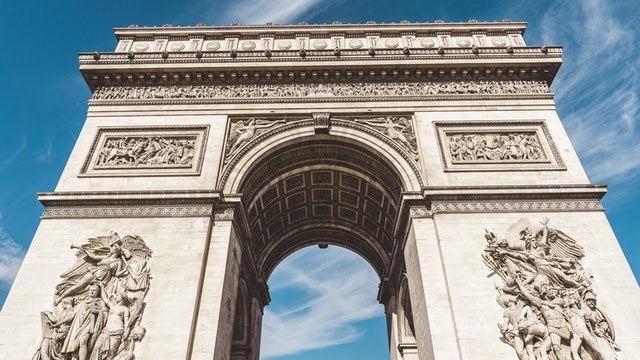
The Champs-Élysées
The Champs-Élysées (1,9 km/1,2 miles long) is the most famous avenue/street of Paris. Mostly known for its luxury shops, expensive bars & restaurants & theatres. Besides that, it is the finish of the world’s largest yearly cycling event, the Tour de France.
The Champs-Élysées actually connects the Place Charles de Gaulle with the Place de la Concorde. Another imposing square on which you can admire the Obelisk of Luxor (Egypt).
- Although Napoleon Bonaparte already wanted to ship the obelisk to Paris, it actually arrived years later, in 1833. This time as a gift of Egypt’s ruler Muhammad Ali Pasha.
TravelTips: As for other Paris’ attractions, we recommend buying tickets in advance for the Arc de Triomphe. IMPORTANT to know: To get to the highest level you have to climb the 284 steps. The elevator is only accessible for people with a disability & one accompanying person.
* The Arc de Triomphe provides free entrance for people under 18 & and for EU-residents between 18-26 years of age. As well as for people with a disability & one accompanying person.
* To learn more, click on:
Other attractions in the vicinity of the Arc de Triomphe:
As the Arc de Triomphe stands at the end of 12 major avenues, it stands alone. That is, not really within walking distance to other attractions.
A visit to La Maison Victor Hugo, Le Marais, Paris
The French writer Victor Hugo (1802-1885) is world famous. Mainly, for his novels Les Misérables & The Hunchback of Notre Dame. Besides being a gifted writer – of nearly every genre – he also produced beautiful artistic drawings.
Fans of the writer can visit his former residence – where he lived between 1832 and 1848. On the second floor you can get an impression of his living quarters, while the first floor is used for temporary exhibitions.
TravelTips: And one more reason to visit Victor Hugo’s Mansion, … entrance is FREE.
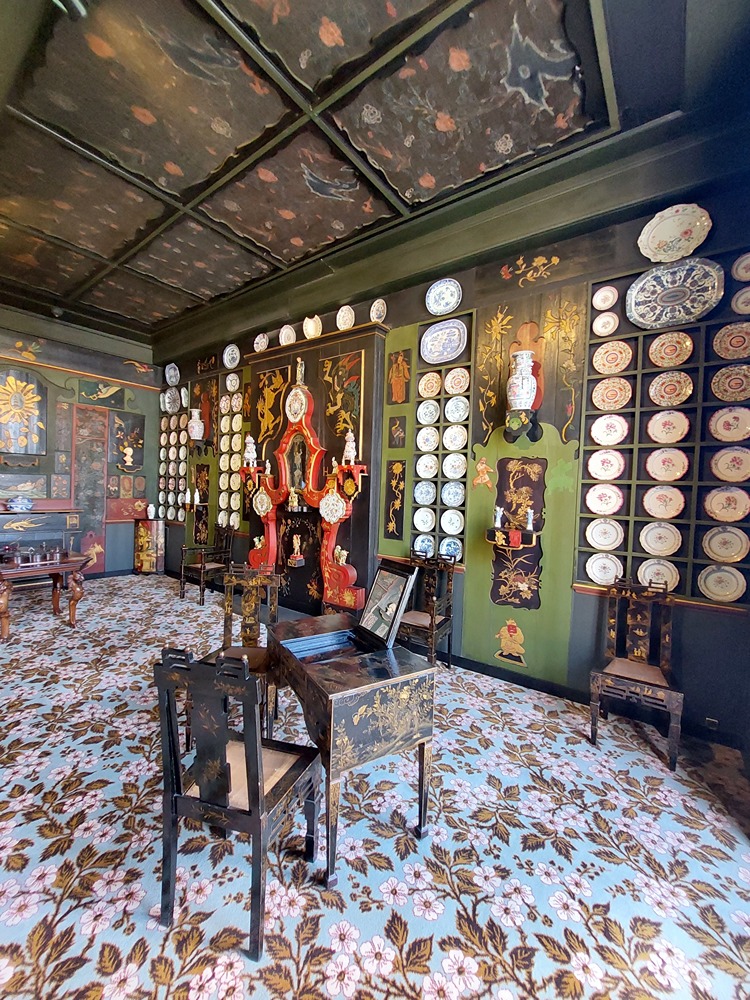
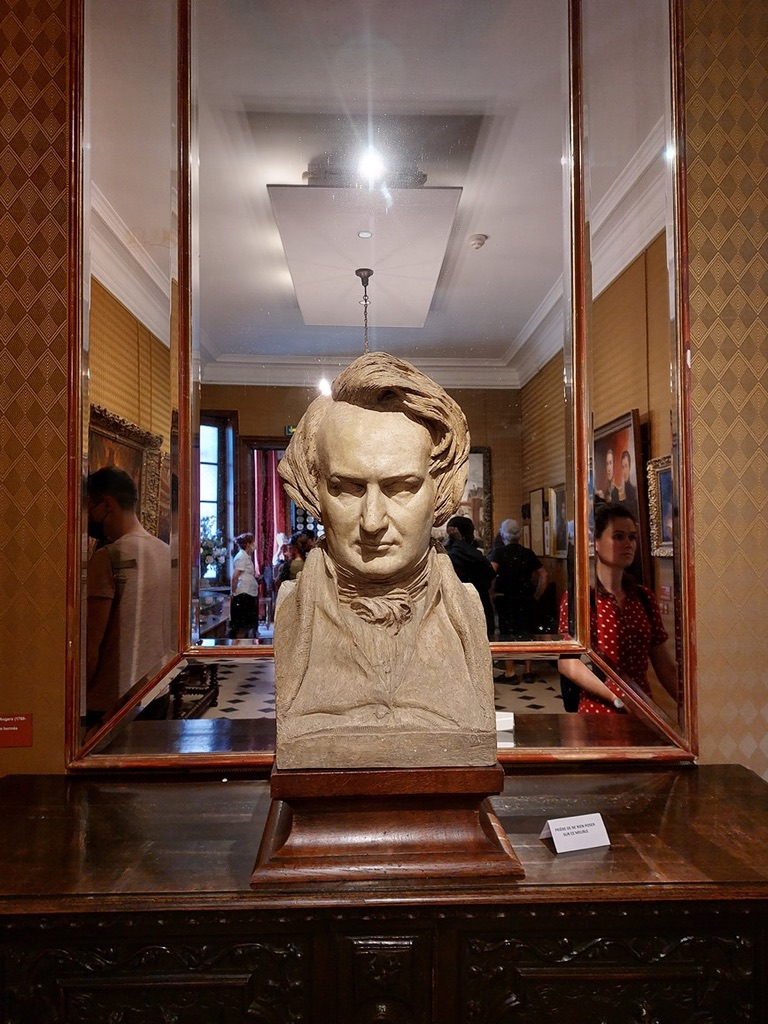
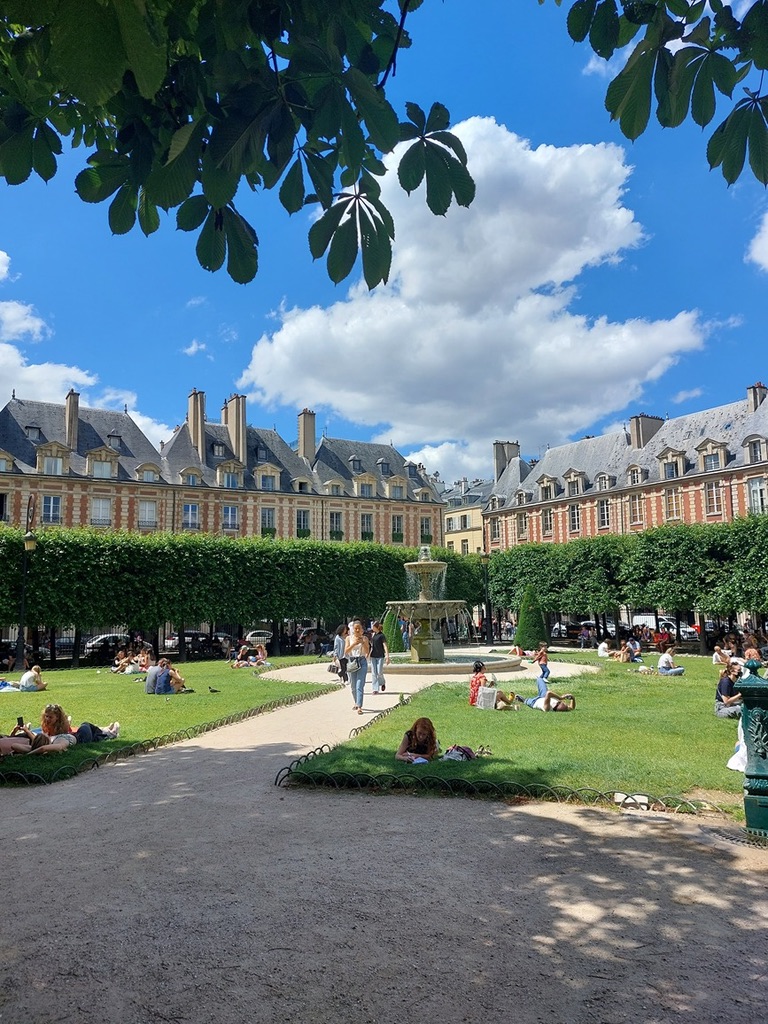
La Maison Victor Hugo is located in one of the most lively parts of Paris, Le Marais. A historic neighbourhood which somehow escaped the Hausmann Makeover of Paris in the second half of the 19th century.
Le Marais is probably the most romantic part of Paris. A lively neighbourhood, full of bars & small restaurants, trendy shops, parks, squares & cobblestone streets. Ideal for strolling around for a few hours.
For that reason, Le Marais is one of the best areas to: Search for a hotel
Other attractions in the vicinity of La Maison de Victor Hugo:
Victor Hugo’s mansion is located at the beautiful Place des Vosges (park). Nearby, you can also visit the Picasso Museum, as well as the Holocaust museum (Mémorial de la Shoah) and the Paris’ History Museum (Musée Carnavalets).
A little further away, but still within walking distance, you can find the Centre Pompidou – center of Modern Art.
TravelTips: Especially for Harry Potter fans who visit Paris. In this part of town – in the Rue de Montmorency – is the former house of Nicolas Flamel (1330-1418). It isn’t possible to actually enter the house (only if you want to visit the Haute-cuisine restaurant inside), but on the outside there’s a plaque indicating that Flamel lived there.
- Nicolas Flamel actually was a French scribe & bookseller, who somehow – centuries after his death – developed a reputation as an alchemist. He supposedly created the Philosopher’s Stone with which to convert metal into gold & prolong one’s life. His fame lives on in many ways, as for example in books by Victor Hugo, Dan Brown, Umberto Eco, Paulo Coelho & J.K Rowling.
Finally, another attraction you can visit in the Paris neighbourhood of Le Marais is the Marché des Enfants Rouges. It’s one of the oldest markets of Paris where – besides all kinds of foodstuffs – you can find several exclusive food stands.
TRAVELTips: How expensive is a visit to Paris?
Well, first of all: Paris is an expensive destination. Like almost every major metropolis, like Rome, London, New York or Tokyo. Mainly caused by the presence of so many MUST SEE attractions. Exclusive things to do, like a cruise on the Seine or maybe Disneyland with the kids, luxurious hotels, bars & restaurants.
Everything depends of course on what you want to do & how you want to do it.
- Buy individual tickets, or a city pass.
- Book a luxury hotel, or look for something less expensive.
- Let yourself drive around in a taxi, or use public transport.
- Eat out every day, or settle for a good snack/self-organised picnic once in a while.
- Visit attractions all day, or alternate with relaxing moments in parks and/or walking certain neighbourhoods.
- Buy everything you like, or buy some smaller, specific souvenirs.
All these choices determine how much your stay in Paris will cost.

Popular DAY-TRIPS from Paris
There are many options for out of town day-trips from Paris, of which I will mention the most popular ones.
A visit to the Bois de Vincennes, Paris
Let’s starts with one that’s still within the city’s boundaries. To the east of the City Center you’ll find the Bois de Vincennes. A big green area – bordering an impressive Chateau (which you can visit) – with several lakes. Ideal for biking & hiking, but also to visit some entertaining & fun activities.
TravelTips: In & around this green park you can choose between: a visit to the Zoologique de Paris, the Aquarium de Paris, a Botanical garden (Arboretum de Paris) & an Ecological park (Jardin de Papillons & Parc Floral).
Perfect if you have the time, or want to escape the inner city for a while & relax a little. An ideal place for yourself, but also with children.
A Day-trip to the Château de Versailles
A little further away – but still close – you’ll find the most popular day-trip from Paris, a visit to Versailles, which attracts millions of visitors every year. By far, the biggest symbol of France’s Royal past. In the first place Louis XIV – the Sun King – who gave the order to build it.
- Louis XIV actually wanted to transform the former hunting lodge of his father into a château. A residence for him, but also his huge court & his government.
- Construction started in 1673, and lasted about fifty years. While the palace & surrounding gardens got bigger & bigger, the former village of Versailles slowly disappeared.
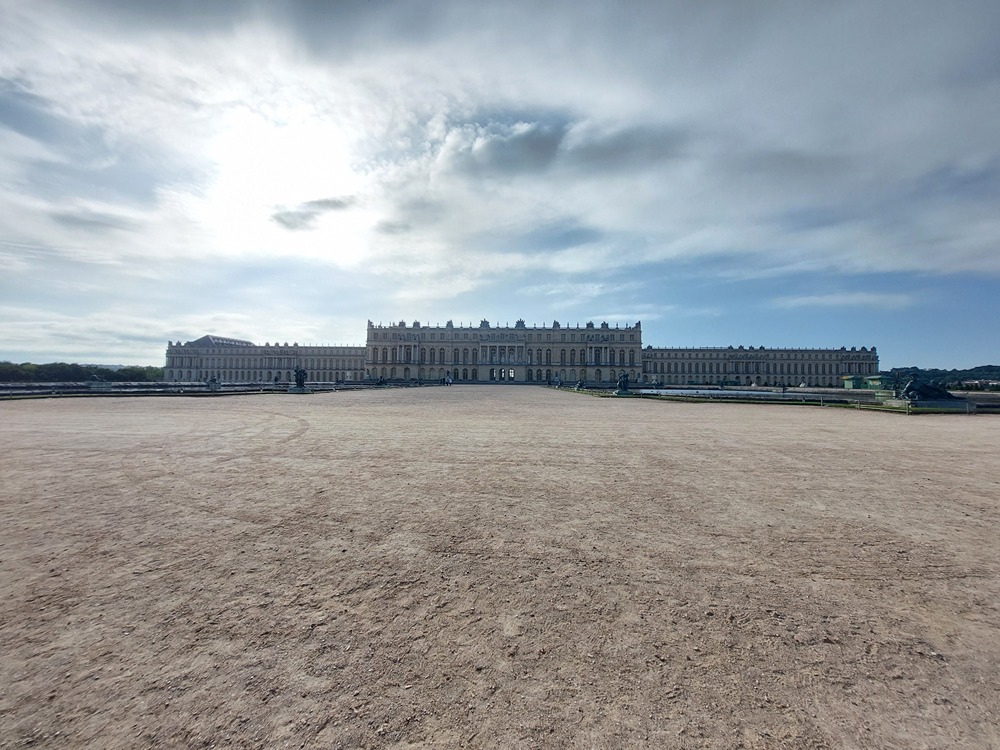
Peak of absolutist power
Soon, the palace – one of the largest in the world – became a symbol for absolute power & decadence. The king as a god, the Sun God. A man who ruled France for more than 72 years. (Still a world record. Although Queen Elizabeth II of Britain came close.)
In that sense, Louis XIV’s enormous power was – in many ways – a prologue to the French Revolution of 1789. A revolution that ended the French monarchy. Well, after a few last Royal hiccups.
- After the fall of the monarchy in 1789, France went from a republic to an empire under Napoleon Bonaparte. After his downfall (1814-1815) though, it shortly became a monarchy again, before in 1848 the final curtain fell for French royalty.
A museum since 1837
Although the French renounced its absolutist past through a revolution, Versailles wasn’t destroyed. In 1837 it was converted into a museum.
- Ironically commissioned by the last king of France, Louis-Philippe de Orléans – the “Citizen King” – who initially converted Versailles into a History Museum. Little by little though, the former palace was restored to its former glory. Nowadays, it’s mainly a monument to remember the extravagance of the Ancien Régime.
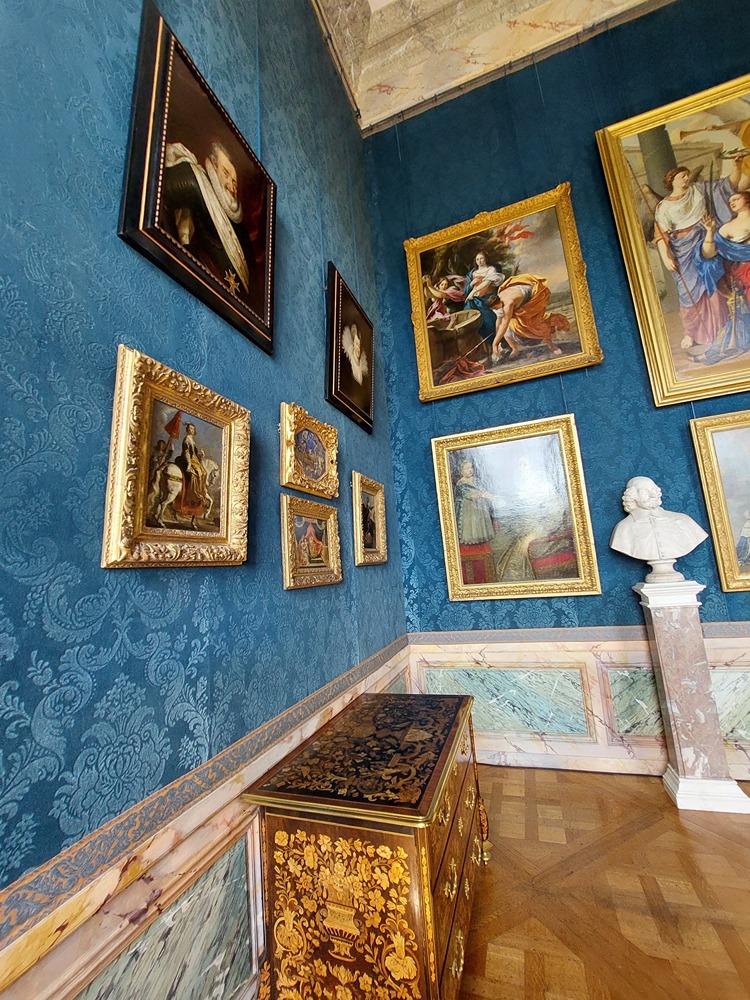
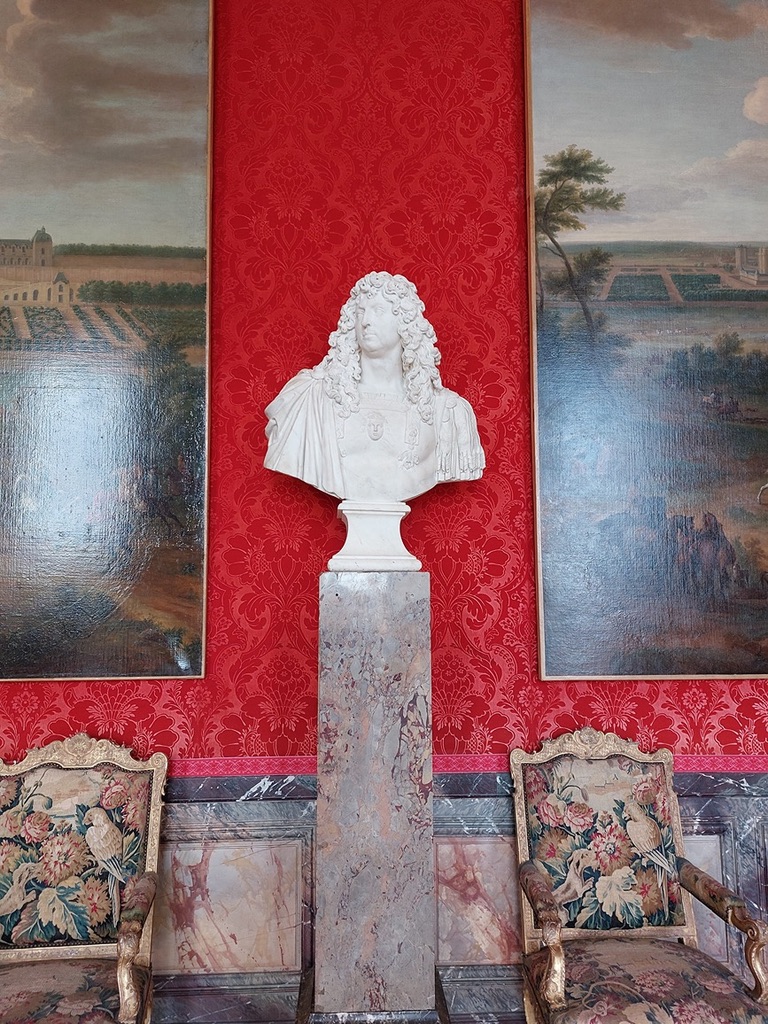
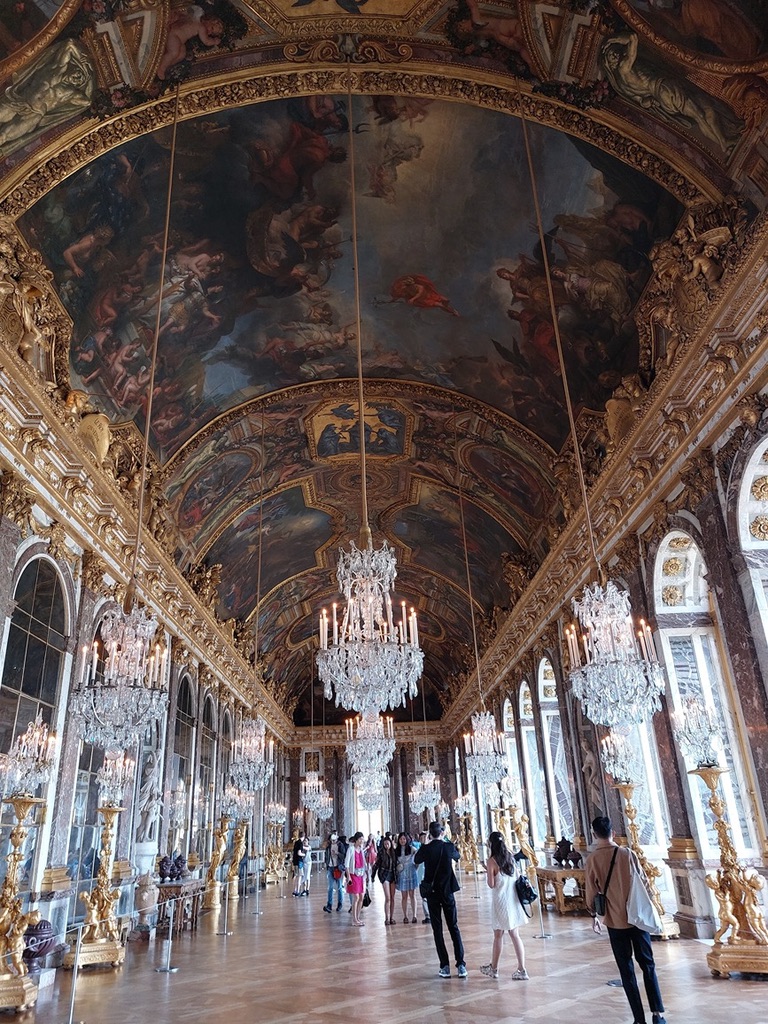
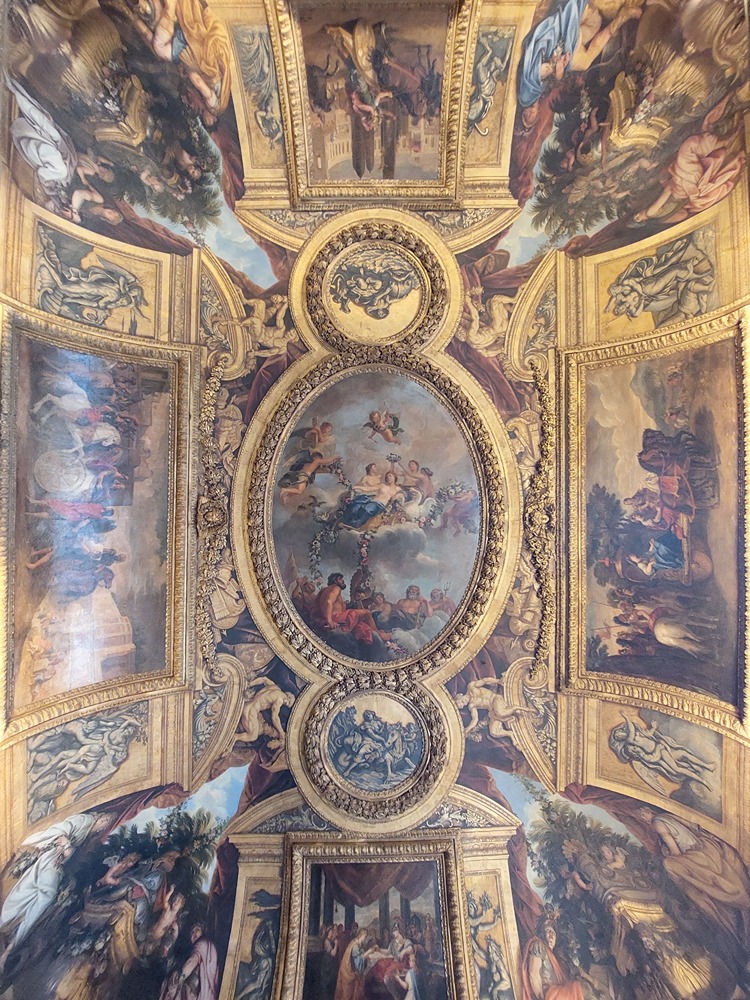
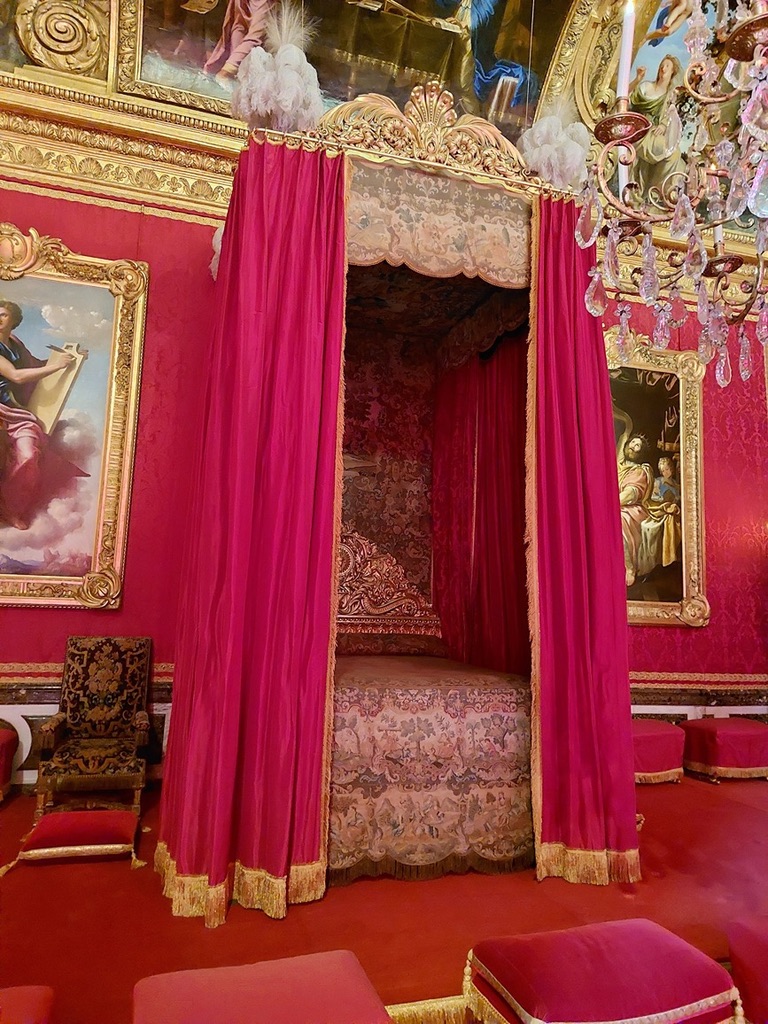
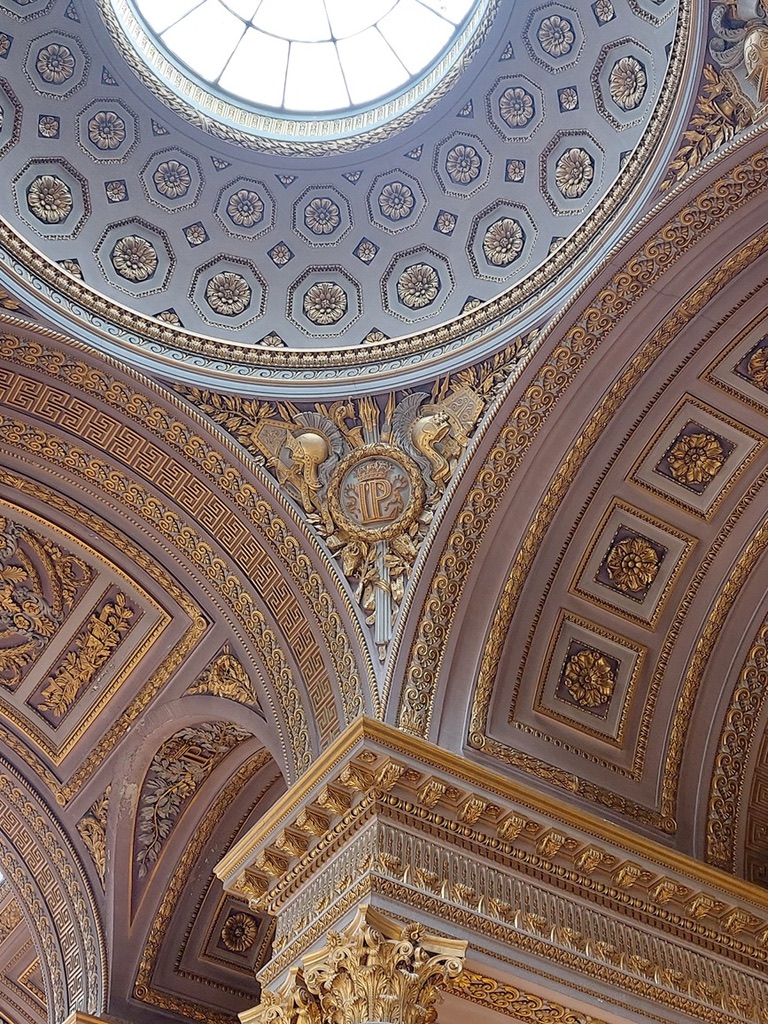
Prepare your visit to Versailles Palace & Garden
TravelTips: Because Versailles – with over 2300 rooms & extensive gardens – is soo enormous, it’s best to reserve at least half a day for a visit.
For most visitors the absolute highlight is the Mirror Room. It’s mainly known for its design, but also as the spot where the famous Treaty of Versailles was signed in 1919, after World War I.
Other rooms that attract visitors the most are: the King’s Apartments, the Royal Chapel, the Royal Opera, the Queen’s Apartments & Marie-Antoinette’s private chambers.
Every room has its own character. However, these are always stuffed with royal glitter & glamour. So much glitter & glamour it sometimes may start to dazzle you or even make you dizzy.
Just kidding! However,… it may happen. Which, above all, indicates that it’s time to head out to the garden & take in some fresh air. An area where you can easily spend a few more hours. Famous as it is for its typical design, the walkways, the canals, dozens of fountains & the orangerie.
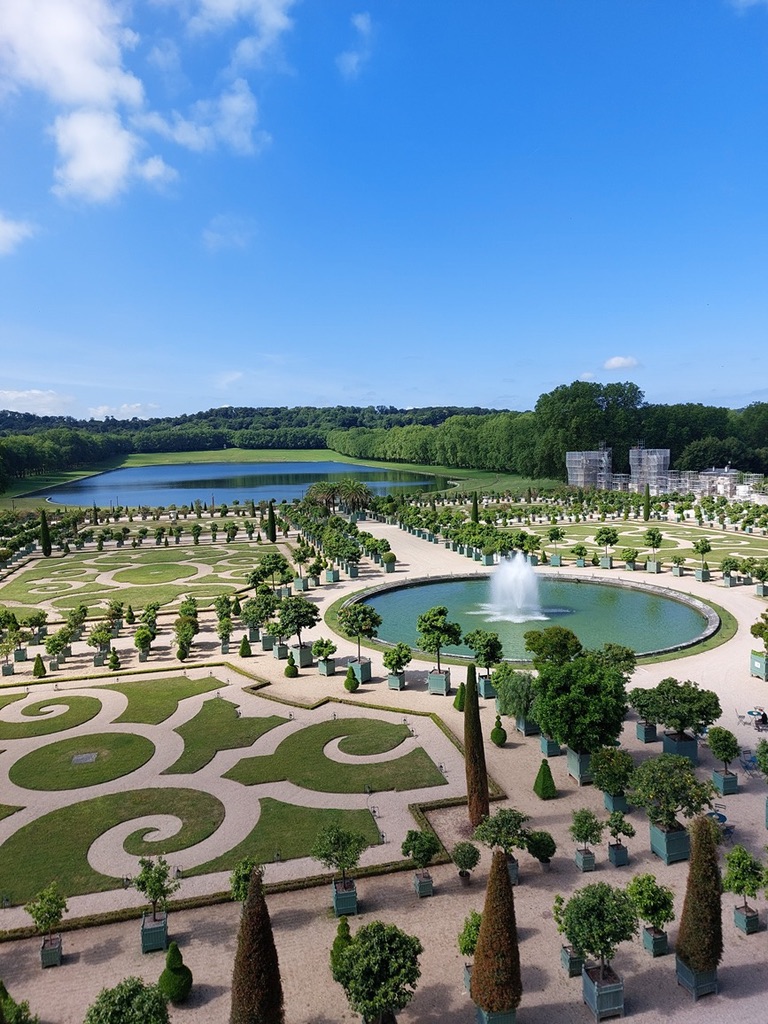
A visit to the Estate of Trianon
Besides the palace & the gardens, you can visit the Estate of Trianon. For the former royal inhabitants of Versailles this was a private area. It includes the, nowadays highly popular Queen’s Hamlet.
- Le Hameau de la Reine is a country-style house & surrounding mini-village, which was especially built for Queen Marie-Antoinette to relax & meet her friends.
IMPORTANT: If you want to visit the Estate of Trianon, you have to include it in your Entrance Ticket to Versailles!
*****
The best tip we can give you on Versailles is to start as early as possible. The palace opens daily (except Mondays) at 9AM, but the gardens already open at 8AM. (The Estate of Trianon opens at noon).
To cover the extensive gardens, it’s possible to hop on the little train or to take a boat ride on the canals. But you can also rent a bike or a golf cart, with which you can also visit the area around Versailles. A perfect place for a picnic (for which lockers are available at the entrance).
Buy tickets in advance for Versailles
In any case, it’s recommendable to buy tickets in advance. You gain a lot of time (during the high season, but also during the low season).
- If you do or already did, you can skip the line in front of the Ticket Office & head directly to Entrance A, on the left hand side of the Honour Courtyard in front of the palace.
* Important though to know that Versailles also provides free entrance for people under 18 & and for EU-residents between 18-26 years of age. As well as for people with a disability & one accompanying person.
To buy your ticket to the palace only:
Or if you want to include the Estate of Trianon as well:
How to get to Versailles?
If you don’t have your own transport, the easiest & cheapest way to get to Versailles is by train. To be more specific, Line C of the RER regional train system. The train brings you to Versailles in just 30 minutes (3,65€ one way).
Alternatively, there’s also the possibility to include transport (generally by shuttle bus) from Paris in your ticket to Versailles.
To learn more:
A visit to Fontainebleau
If you have already visited Versailles or just want to avoid the daily crowds, there’s a good alternative near Paris: is the Château de Fontainebleau. A lot smaller, but still large enough to spend hours in the palace & garden.
- Construction of Fontainebleau started in the 12th century. The palace served as a residence for many kings, as well as the two French emperors, Napoleon I & Napoleon III.
Fontainebleau has its own eventful history. Something you notice soon enough, when visiting the many rooms of the Chateau. It’s surely not as luxurious as Versailles, but still… lots of glitters & glamour. Something the Bonapartes weren’t immune to either.
TravelTips: Fontainebleau is located 55km/ 34 m south of the center of Paris. Reachable within an hour by train & bus.
* The Chateau provides free entrance for people under 18 & and for EU-residents between 18-26 years of age. As well as for people with a disability & one accompanying person.
To learn more and/or buy your ticket(s) in advance:
TRAVELTips: Transport heading out of Paris
If you decide – during your visit to Paris – to head out for a day or multiple days, there are several options.
Public Transport
Trains & buses go almost everywhere in France (& Europe). Best is to book ahead, which is sometimes cheaper as well.
To buy tickets in advance, you can go directly to the website of the French National Railway Company (Société Nationale des Chemins de Fer Français) – www.sncf-connect.com.
Taxi
Another option for sure, but fairly expensive.
Rent a car
A little adventure always, but also providing you with the freedom to go wherever you like. And after all, in Europe it’s not soo expensive as you may think.
On a tour
Finally, the most relaxed way to go on a Day-Trip is to Book a tour (including transport from Paris).
There are many agencies to choose from, but when it comes to a guaranteed & well organised Day-trip I’ve chosen Tiqets & GetYourGuide – both Europe based – as the best ones in quality & price.
A tour of the Battlefields of Normandy
Another popular day-trip from Paris is a historical one. A visit to the Battlefields of Normandy. First of all, the famous beaches – Utah, Omaha, Gold, Juno & Swords – on which the allied forces landed on June 6th 1944, D-Day. The start of the liberation of Western Europe.
* BookTip: I recently read the latest book on D-Day & the Battle for France: Normandy ’44, written by James Holland. Highly recommended, if you want to read yourself into it, before visiting the battleground.

TravelTips: An All-Day tour from Paris generally includes – besides transport & a guide – a visit to one or two beaches – foremost, Omaha Beach, where most soldiers fell (mainly of the US Army) – a museum, a cemetery & a typical French village nearby for lunch.
Studying the day-trips several tour-operators offer, I think the best option is GetYourGuide Mainly, because they make some interesting extra stops.
To learn more:
A Day-trip to Mont-Saint-Michel
Le Mont-Saint-Michel is a rocky, tidal island in Normandy, France. The island lies approximately 1km/0.6miles of the mainland.
At the moment, only around 50 people live on the island, it gets millions of visitors every year. Mainly to visit the Abbey (of Benedictine origin & gothic in style) & the village around (full of shops & several small museums).
- The island was already a pilgrimage site soon after Christianity spread in Western-Europe, in the 5th century.
- Construction of the abbey began in the 10th century, partially over an older church. From the second half of the 15th century though, the abbey was used mainly as a prison by the Ancien Régime. That is, until the French Revolution.
TravelTips: The island is accessible all day – independent of low or high tide – but can’t be reached by car. However, you can park your car on the mainland & walk the causeway (800m/0.5miles) or take a shuttle.
If you have your own transport or have Rented a car, it’s possible to combine the Normandy beaches of D-Day (see Above) with a visit to Mont-Saint-Michel…. But in that case, you have to start early from Paris.
Finally, you can go with an All-Day-tour (including tickets to the Abbey).
To learn more about a Day-tour to Mont Saint-Michel (& see dates available), click on:
A Visit to Museum Claude Monet, Giverny
For the fans of the French impressionist Claude Monet there’s the possibility to visit his former house & atelier in Giverny. Located only 80km/ 50miles west of Paris, on the banks of the river Seine.
- Monet lived in the beautiful house & gardens for 43 years. From 1883, until his death in 1926.
- The museum was inaugurated in 1980. The living quarters & gardens are brought back to its old style (including the famous flower beds & lily ponds).
Giverny is a small French Village located in Normandy. The close proximity to Paris makes it possible to visit the museum in half a day.
Another possibility though, is to make it a full day-trip, combining Monet’s former house with other attractions around. Like a visit to the local Museum of Impressionism, Monet’s last resting place, and of course the little village of Giverny itself & the surrounding area.
You can reach Giverny by train & shuttle bus (approximately €25 round trip). Or else, by an organised tour.
* The museum is free for children under the age of 7. People with a disability get a 50% discount.
* IMPORTANT: The museum closes every year, from November until April.
To learn more about the tour to Giverny (& see dates available (!) because the museum closes from november until april), click on:
A visit to the Wine Fields of Champagne
Another highly popular All-Day tour from Paris is a visit to the Champagne wine region. Generally included – besides transport & a guide – is wine tasting, an exclusive French lunch, a visit to one or two typical villages in this northeastern region of France.
TravelTips: For this special Day-trip, I like to recommend GetYourGuide, which present several options when it comes to tours to the Champagne-region.
To learn more, click on:
Visiting Disneyland Paris
Finally, … what to think of a 1-Day or Multi-Day visit to Disneyland Paris?
A visit I really don’t have to introduce to most of you. A fun experience for everyone, but especially if you travel with your family or friends.
To buy your tickets for Disneyland Paris in advance, click on:
When you want to include transport, click on: Disneyland from Paris.

Last TRAVELTips: Before you visit Paris….
The Best Flight to Paris, France
There’s a chance you’ve already booked your flight, but if not and you’re still searching for the best & cheapest flight … I – for one – recommend CheapOair.
A website that in a few seconds checks all flights available at that moment and compares prices & flight times.
To learn more, visit: CheapOair.
How to get from/to the Airport
There are three airports in Paris: Charles de Gaulle (CDG), Orly & Beauvais. The first two airports are well connected to the city center of Paris. Beauvais is located a little farther away and is mainly used by budget airlines.
The best & cheapest way to get to the city center is by train. The train operates between 5am & 12pm (midnight), stops at every main station in Paris, including the Gare du Nord).
- From Charles de Gaulle (CDG) to Paris: take an RER B train (every 10 minutes), which takes around 30 minutes to the city center. Price: around 10€.
- From Orly to Paris: In this case, you first have to take the Orlyval metro service to the Anthony train station. Change to train line RER B or RER C for Paris. The total journey takes approximately 1 hour. Price: around 12€.
- From Beauvais to Paris: First you have to take the bus to the train station in the city of Beauvais (4km). From there, take the TER 19 train to the city center. Total journey, 2 hours. Price: around 15€.
Alternatively there are also buses (public & express), and of course the option to take a taxi or even arrange a taxi/transfer beforehand. Surely more expensive, but sometimes the best option if you arrive late, had a long flight and/or are arriving with quite a few suitcases.
If you prefer to arrange a private transfer beforehand, we’d like to recommend the following transfer-service to/from one of the Paris Airports (click on their names to learn more):
*****
As a conclusion, there are so many ways to enjoy the City of Light. We hope this post has helped you to plan the perfect visit to Paris. Bon Voyage!
For an overview of all travel posts of my blog, go to: the Home Page.
